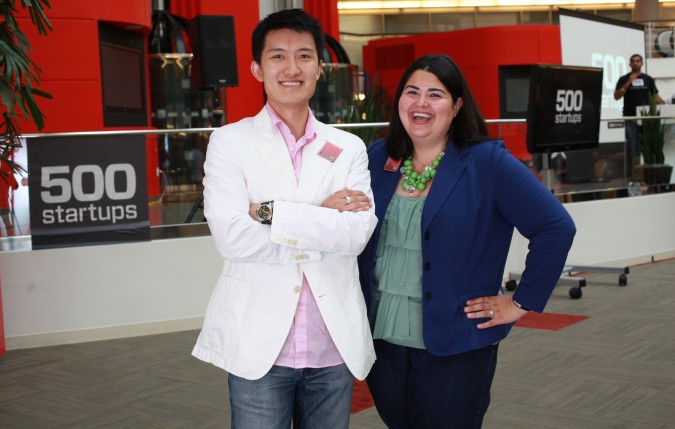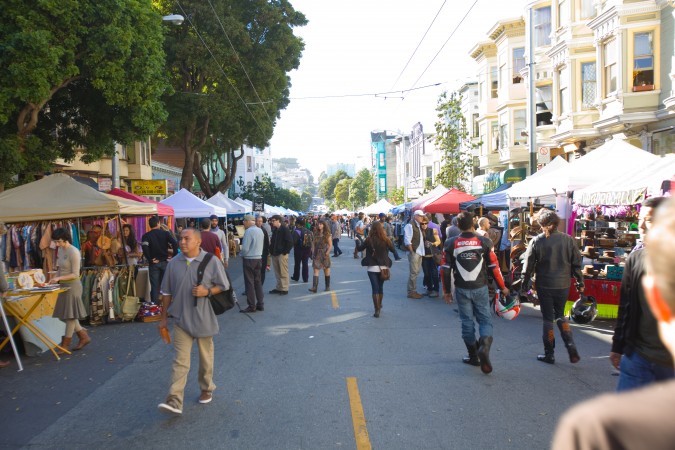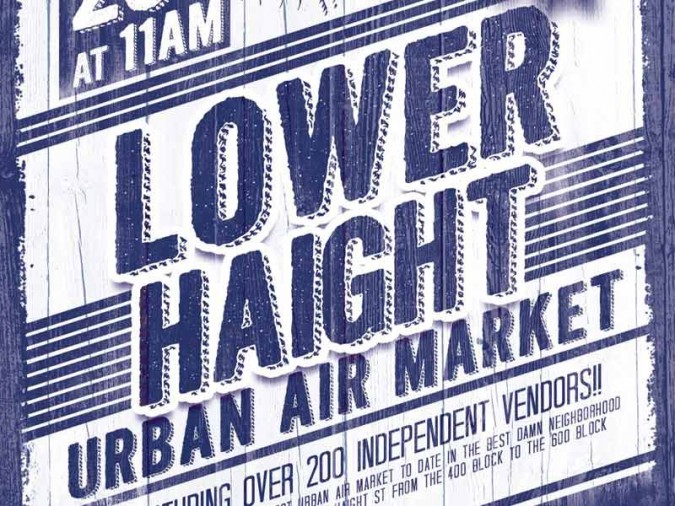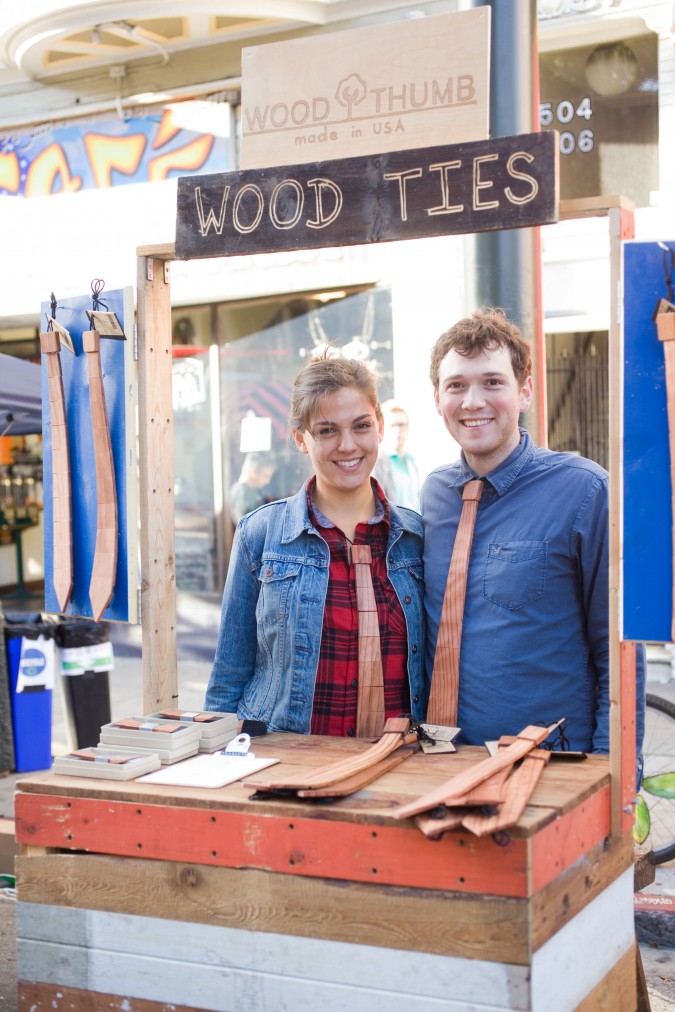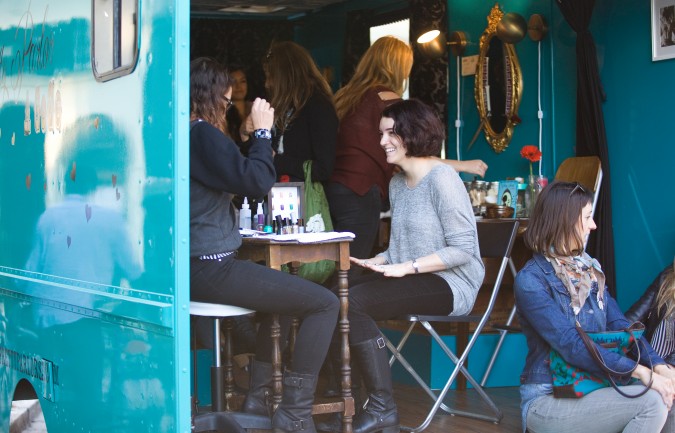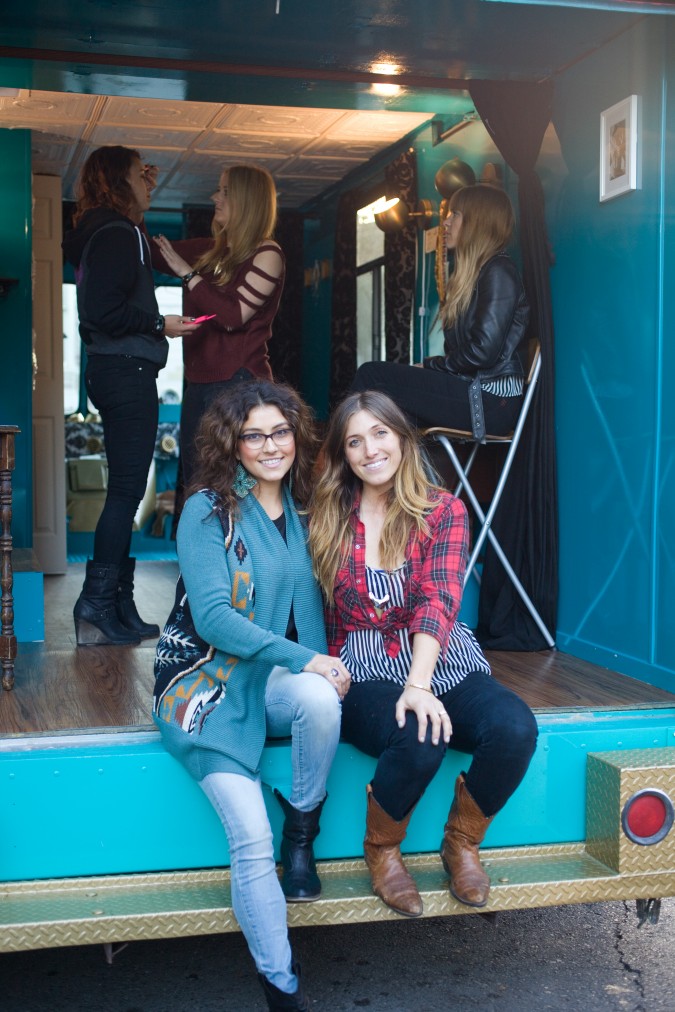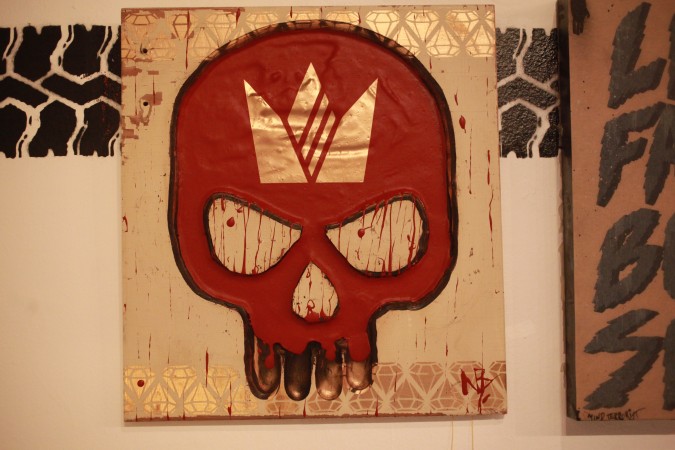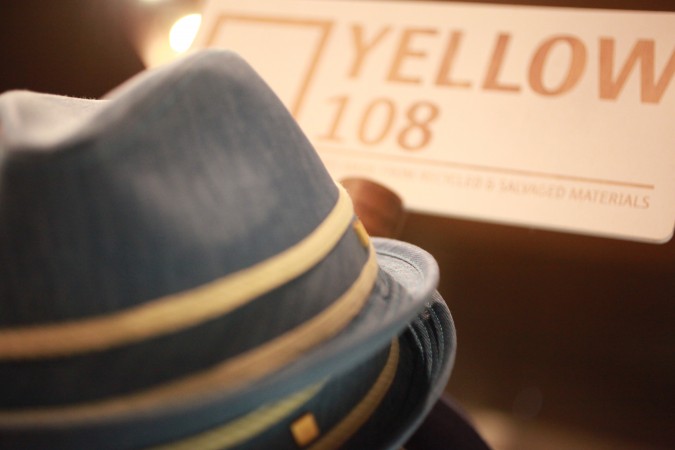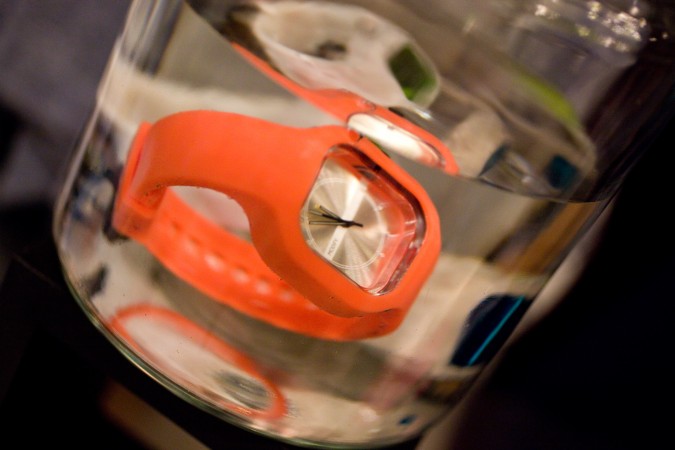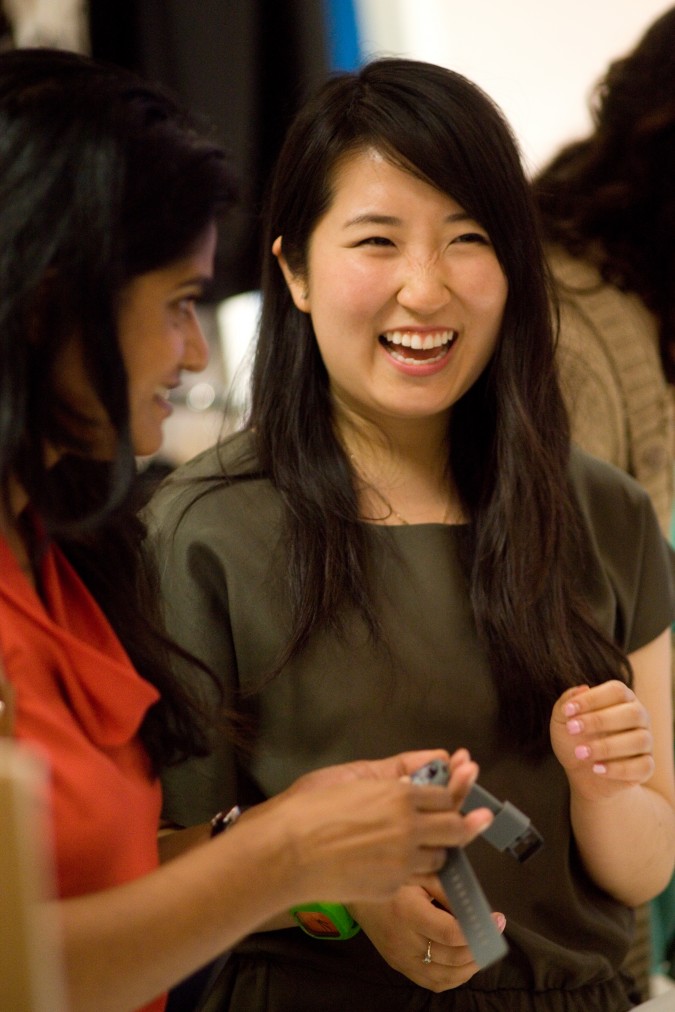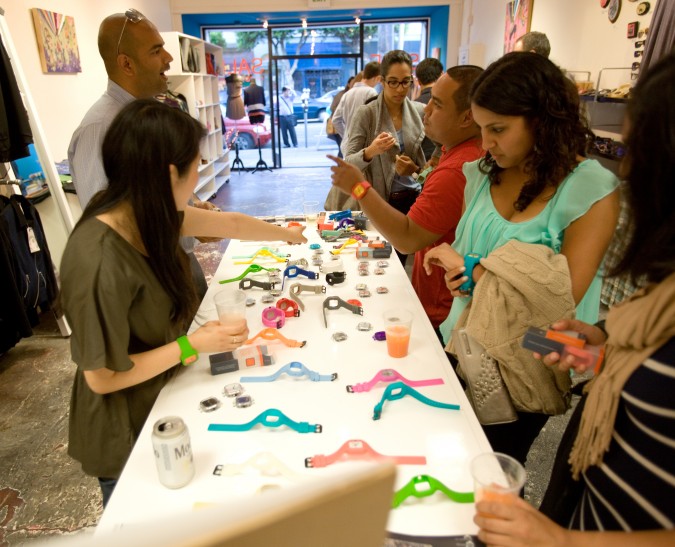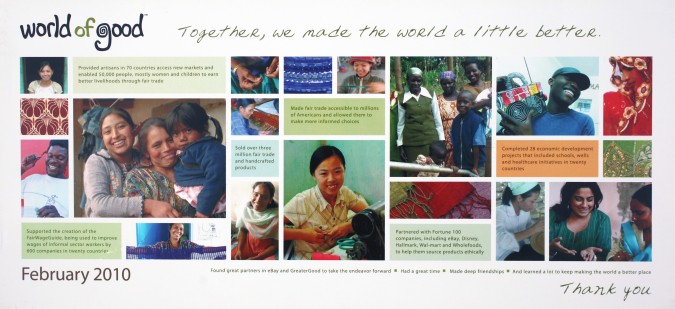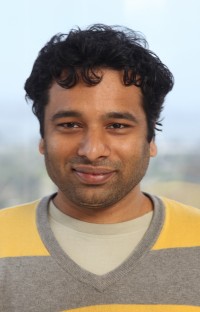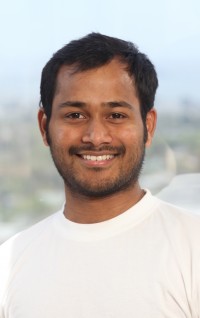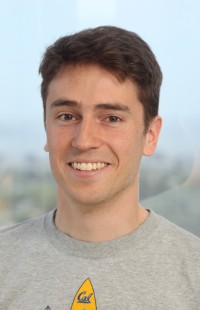Archive for the ‘Startups’ Category
First annual Intel Make it Wearable competition November 2, 2014
On Sunday afternoon, November 2, 2014, I had the pleasure of attending the first annual Intel Make it Wearable to identify exciting technology companies making or proposing to make computers that one wears rather than carries or is stationary.
Make it Wearable is an ambitious new competition, and it’s the most polished and exciting competition I have attended. That’s saying something as I have attended dozens of competitions over the years.
The ten finalists come from China, Chile, the United Kingdom, Germany and the United States. The ideas were wonderfully diverse as you’ll soon learn which helped to keep the event lively and full of surprises. Sex appeal for business competitions is desirable because it helps attract the press and future competitors. I saw reporters from Yahoo and CNet at the event, and even reporters from the Middle East.
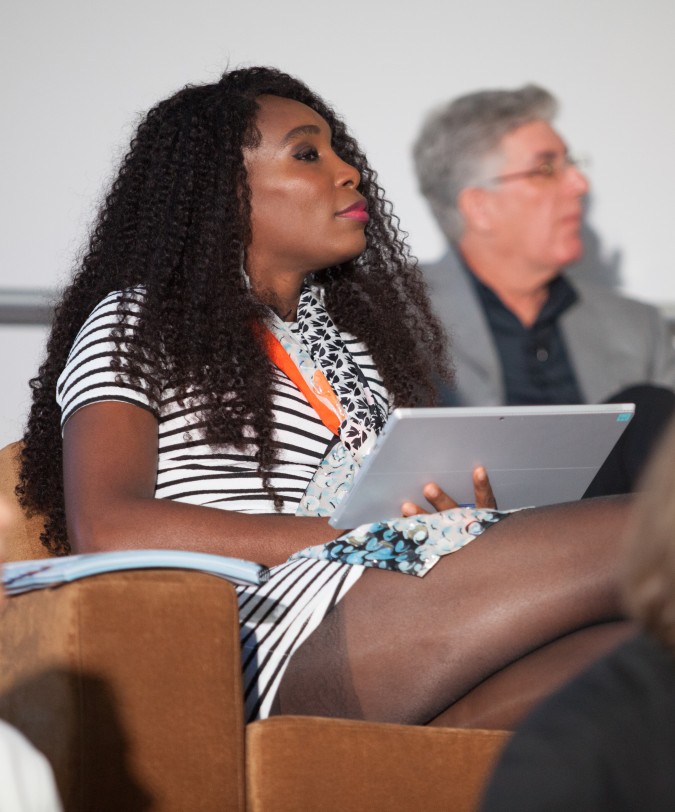
Venus Williams listening to a pitch as a judge for the 2014 Intel Make it Wearable competition on November 2, 2014. Note the Intel chip containing Microsoft Surface Pro tablet computer Williams is holding. The judges voted via these tablets.
Before I jump into the companies, allow me to talk about the event venue, the W Hotel across the street from the Moscone Convention Center in San Francisco, California USA. This was a great choice. The W is very fashionable. It’s not dull and boring like so many big hotels. Intel didn’t just go with a standard W event room though. A designer outfitted the rooms with custom wall textiles that resembled old barn wood and white painted bricks. This theme carried through to the custom printed name tags. There were light sculptures that featured dozens of clear globed incandescent light bulbs dimmed enough you could see the glowing filaments without squinting. These bulbs were dangling down on wires, and the idea was to reference the light bulb over the head to bring up the idea of a fresh new idea being thought up.
There was a disc jockey ever present in the two rooms, though one used her RFID embedded fake fingernails to manipulate a musical track by dipping her fingers in a shallow clear box of water. She got a lot of attention for this, and it was mesmerizing to watch. I learned this was her first gig playing music by playing with water.
The rooms were packed, and the crowd was surprisingly stylish and hip… far, far more hip than the crowds at the business competitions I have attended on college campuses. The only negative is that the event was not open to the public, a big change from previous Intel business competitions I have attended for years in Berkeley, California. I suspect the reason is that this first year was an experiment for Intel, and they wanted to test things out before widening the audience base. I was invited by Intel, a company that has been very kind to me over the years. My last Internet startup was an Intel Capital portfolio company.
My favorite company is Pro Glove, out of Germany. This team won third place and USD $100,000 in the competition.
Pro Glove makes solutions to improve the accuracy and speed of production factory workers. The company says there are 200 million such workers in the world.
The company sells gloves, sensors and software to process the data returned by the globe embedded sensors. Factories apparently for the first time can see exactly what workers are doing with their hands. If a worker skips a production step, the software can spot the mistake and flash a light on the glove to warn the worker to go back and complete the step. The glove analytics software can even tell where the worker is standing in the factory, so if they are walking around needlessly to fetch tools, the manager can spot that an perhaps move the tools closer to the worker to save walking time.
Pro Glove said that for BMW, each second saved on a repetitive task making a car translates into USD $7,500 per year savings for BMW, so having analytics about hand movements of production workers strikes me as a must have. Pro Glove cited various return on investment periods for their different use scenarios. Sometimes the system is predicted to pay for itself in a year, and sometimes in just there months.
I can see Pro Glove gloves being a must have in leading edge factories, and I can see room for lots of follow on products that will have high margin, particularly for the software designed to analyze the glove data. I think a large and enduring business can be built, and that is why I give this team my highest vote.
My second favorite team is Open Bionics, out of the United Kingdom. This team won second place in the competition.
Open Bionics proposes to make low cost three dimensionally printed bionic hands for children. The team proposes a price of just USD $2,000, which apparently is shockingly low compared to current bionic hands, which they said can cost up to $100,000 each.
The Open Bionic model is not as durable or as functional as the models costing 50 times more, but the low cost allows families to fit their handless children with a bionic hand multiple times as needed as they grow up. Apparently insurance won’t pay for a new $100,000 bionic hand each year for a growing child, so handless kids just grow up without handless until they stop growing and can get a fully featured metal bionic hand. Open Bionics was not specific about how current costly models are paid for and how often they are replaced, thus I am reading between the lines a bit here in this paragraph.
The Open Bionic team proposes to keep the cost low by not having patients meet with any medical professionals. Instead, the company will send an Apple iPad brand computer tablet with a 3D scanning attachment to the patient by postal mail. The customer will scan their own arm stump and return the iPad to the company. The company then prints out and assembles a hand that will fit the exact stump dimensions of the patient, and the hand will just show up at the customer’s home by common carrier, to be self installed by the customer.
The hands don’t have a wrist joint, but they can open and close by the wearer just thinking the same thoughts handed people think when they want to open or close their fist. There are electrode sensors that are taped to the forearm of the wearer, and the Open Bionic team had the electrodes on his own arm, and could make the bionic hand open and close just by his thoughts controlling his forearm muscles. It was an impressive demo.
I got to play with one of the bionic hands, and I could feel the hand squeezing my hand when activated by a push button ‘demo’ switch.
Open Bionics has the opportunity to dramatically improve the life of handless children. The price proposed frankly seems too low to keep the company afloat, so I worry about their viability. But the price can be adjusted, and since the team won USD $200,000 in this competition, they have some breathing room to figure out both their technology and the business.
My third favorite team is Nixie. This team won the grand prize in the competition — USD $500,000.
Nixie had the most eye popping video demonstration of their product.
Nixie proposes making a tiny drone helicopter that contains a still and video camera. The drone can fold up and wrap around a person’s wrist. With the flick of the wrist, the drone can be unfolded and then can start up and take flight away from the wearer. Once at a suitable elevation and distance, the camera can face the use and take a picture or start recording. Once done, the drone will fly back to the user and turn off.
Nixie sees itself as a competitor to Go Pro and similar action cameras. Eventually Nixie says they want to compete with normal point and shoot digital cameras.
I held a prototype Nixie drone in my hand, and it is cute. However, it looks impossibly fragile and totally unsuited to wearing while rock climbing, the stated first market Nixie envisions. I can see the drone simply falling off the wrist and falling on someones head below.
But I am happy Nixie won first place in this competition. The idea I think will wow many observers, and it will help brand the competition as one where really cool consumer products can be born and launched. That’s good for Intel and good for the competition.
But I think Nixie won by making the drone wearable as a way to be eligible to compete in this competition. In the absence of the competition, I think the product would have taken a different form. If I were rock climbing, I would want the drone in a protected case that I could easily open and access when the time was right for taking pictures.
Nixie is likely to be costly to start. I can see it costing USD $1,000 to early rock climbing adopters. I think they will find customers even at this price.
I don’t think there are strings attached to the Intel half million dollar prize, so I think that Nixie is welcome to ditch the wearable aspect in favor of practicality. I encourage them to go that route, even though it may secretly irritate Intel.
I admire Nixie for getting a non dilutive $500K to pursue their photography drone. This kind of thinking is the hallmark of successful entrepreneurs — tailoring an offering for the market at hand. Intel was the customer, and Nixie gave Intel a product it asked for. And Intel will be proud of Nixie even if they just become a successful photography drone company.
I can also imagine ways to make a Nixie both wearable and very unlikely to get damaged during arduous climbing. Just put it into a head mounted hard case inside a custom helmet. When the time comes, the helmet wearer could command the helmet to open and for the drone to take off from there. This could even be voice activated via a helmet mounted microphone.
Sadly, I don’t have time right now to finish this post. My grandmother is turning 103 years old December 12, 2014, and I have a project I have to finish by then as I promised her I would take it to show her. I have already spent three days on this Make it Wearable competition, and I need to get back to my regular life. I have a lot more pictures to post, and I want to tell you about the seven other companies, which also are very interesting.
ShoppinPal.com smart phone app from Fermyon, Inc. improves the brick and mortar retail shopping experience for both buyers and sellers
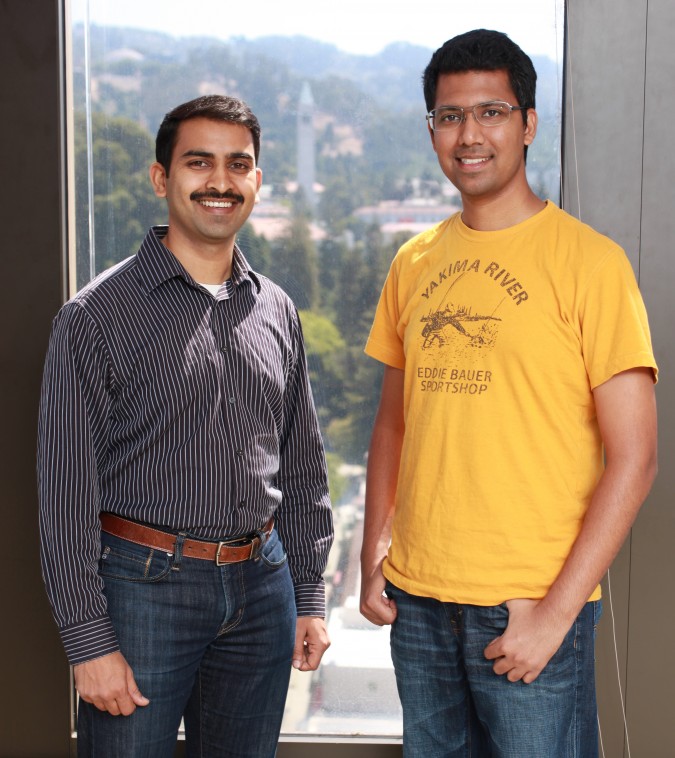
Cofounders of ShoppinPal.com - Sriram Subramanian, CEO, and Pulkit Singhal, CTO. July 26, 2013. Photograph taken at University of California Berkeley Skydeck accelerator, on the top floor of the tallest building in Berkeley, California. That clock tower in the background is on the UC Berkeley campus. Photo by Kevin Warnock.
Fermyon, Inc. is the company behind the impressive ShoppinPal smart phone application that improves the retail brick and mortar retail shopping experience for both buyers and sellers.
On Friday, July 26, 2013, I met with Sriram Subramanian, Chief Executive Officer, 34, and Pulkit Singhal, Chief Technical Officer, 29, the co-founders of Fermyon.
Retailers complain about people treating their physical stores as free showrooms for consumers to touch and evaluate items they will then actually buy online, frequently from giant Amazon. The retailer I suspect feels cheated by these people since they received something valuable, but didn’t make a purchase from the store to compensate the store for their efforts.
Consumers like mobile shopping apps like the one Amazon gives its customers. Smart phone shopping apps let people look up specifications and customer reviews to help them make smarter purchasing decisions. I don’t see shopping apps disappearing, since they offer such compelling value to consumers.
Retailers with physical stores could of course create their own smart phone applications that mimic those from huge online merchants, but it’s mostly larger chain stores that do, because writing a shopping application is difficult and costly.
That’s where ShoppinPal comes in.
ShoppinPal is a service that retailers pay money for — 3% of sales for retailers with over USD $5,000 in monthly ShoppinPal sales, or $49.00 + 3% of sales for retailers that sell less than $5,000 a month through ShoppinPal. This strikes me as assertive pricing, but if it works, Fermyon will be in a position arguably even better than Visa and Mastercard, because Fermyon is not taking any fraud or refusal to pay risk that I can see. On the other hand, no small retailer could hope to deploy a system like ShoppinPal by developing the system itself, and showrooming is a looming problem that likely is motivating retailers to take defensive action.
Shoppers use the service for free.
The retailer gets access to a custom branded application its customers can install on their own phones. In addition, the retailer gets access to an online management console that shows what customers are buying, among many other statistics. Since buyers provide their email address when they install the smart phone app, the store can easily send them custom messages.
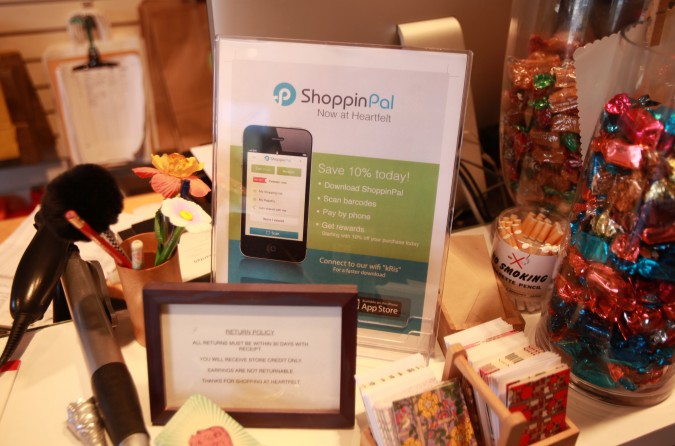
ShoppinPal app display at Heartfelt gift store at 436 Cortland Avenue, San Francisco, California, USA, August 1, 2013. Photo by Kevin Warnock.
For example, if a potential buyer uses the smart phone app to add several items to their ‘wish list’ the store will know about that and can gently remind the potential buyer to return to the store to buy the items. Buyers can be especially enticed to return by being sent discount codes that buyers can use to receive the items at a lower price. Buyers can even opt to have the items delivered to them, offering the convenience of online shopping to the offline world.
I like ShoppinPal. The small team of two co-founders and three staff have put together an offering that appears to come from a larger entity that has raised far more than the modest USD $120,000 in outside capital that Fermyon has taken in.
Buyer engagement potentially starts moments after walking through the door of a shop. One can ‘check in’ to the ShoppinPal app, like one ‘checks in’ on Facebook. The check in alerts store management that the buyer was present.
Next the customer can use the camera on their smart phone to scan the bar code on items they are interested in. The app recognizes the bar code and pulls up that product. The app can, at the option of the retailer, show customers recommendations for other items they may like in their store.
For new retailers, the ShoppinPal cloud based software taps into the retailers’ point of sale cash register system and reviews the receipts for the prior six months of sales. The software sees that people purchased certain items during the same transaction, and uses that set data to recommend that future purchasers also consider such grouped purchases.
CTO Singhal asked current retailers using their system to try the recommendation engine, and those queried marveled at how the recommendations matched with their memory of what many past customers had bought together.
The ShoppinPal app and the website are both beautiful – spare, elegant and clean. The management console is by Mixpanel, a separate company ShoppinPal pays to provide that service.
Sellers can add various incentives for shoppers to buy more items. For example, a discount can be applied after a certain number of purchases. Thus, a coffee shop could automate the ‘buy 10, get 1 free’ paper punch card that still is in use, and was in use at the tea shop where I met with Singhal and Subramanian.
That tea shop in fact allowed customers to store their paper cards in a physical file system on the counter out for the public to access. I marveled the tea shop would put such sensitive information out on public display, because a competitor could surreptitiously copy down a list of the shop’s best and most loyal customers. With quality video cameras in every smart phone, someone could just pretend they were looking for their card while capturing video of every card the thief perused. An electronic loyalty system like that included in ShoppinPal reduces the risk a customer list can fall into the hands of an outsider or an employee that should not have that information.
Inside ShoppinPal, there is not only a wish list, but a gift registry, which should encourage others to buy at a retailer the others may not even be aware of when the items are added to the registry.
ShoppinPal communicates via application programming interfaces to two point of sale cash register systems — Lightspeed Retail and Vend. ShoppinPal hands off to the cash register the precision task of calculating sales tax, sidestepping a thorny problem, since there are thousands of sales tax jurisdictions.
As a customer walks around a store, as they pick up items and place them in their physical shopping cart or basket, they can click ‘add to cart’ within the mobile app. This gives a running total of their planned purchases, and when the customer is ready to pay, they can buy directly from the app, which will display a receipt on screen the customer can show to store staff as they pass through the exit.
This pay within the app feature over time will let retailers hire fewer checkout clerks. The pay within the app feature can be turned off by the retailer that prefers customers visit a cash register to physically run their credit cards through a credit card terminal.
Whether the purchase is paid for in app or at a retailer’s register, the ShoppinPal management console keeps track of all the buyers’ purchases, and makes the purchase history available to the customer, which in my mind is a great perk for the customer. When I shop at Lowes and HomeDepot, I use their loyalty cards mostly because their systems email me a copy of my receipt within minutes after a purchase, which makes my life easier at income tax time.
The sexiest feature of the mobile app is a feature that adds fun to getting a discount. Instead of just writing out ‘you get a discount’ the app presents a silvery gray patch that looks just like the silvery patches covering the digits on lottery tickets. You have to ‘scratch off’ the patch with your finger, and as you rub the screen with your finger, the silvery ‘material’ under your finger vanishes. The effect was startlingly captivating such that I believe a tiny company could be formed just to advance this feature inside other unrelated products from other companies.
ShoppinPal is still an early stage venture. The company was incorporated in January, 2011, but work didn’t really accelerate until CEO Subramanian completed his MBA in June, 2012, last year.
Fermyon has signed up four customers, all via resellers that have agreed to carry their product. I view it as a positive sign that resellers are promoting their product while the company is still so young, for resellers have to be particularly careful to not damage their reputations.
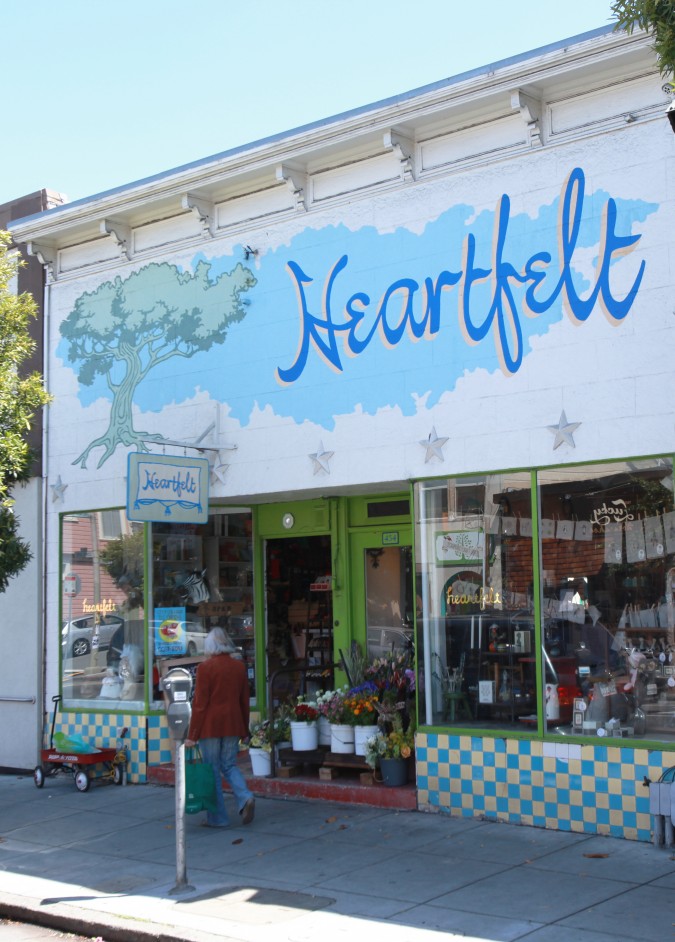
Exterior of Heartfelt gift store at 436 Cortland Avenue, San Francisco, California, USA, August 1, 2013. Photo by Kevin Warnock.
ShoppinPal’s customers are Harney & Sons in New York City, Heartfelt in San Francisco, Isha USA in Tennessee and Marthas Vineyard Glassworks in Massachussets, all in the United States. The Isha implementation is the most demanding, because the organization runs events that draw about 1,000 people twenty times or so per year, so the transaction volumes spike tremendously during events and subside the rest of the year.

Interior of Heartfelt gift store at 436 Cortland Avenue, San Francisco, California, USA, August 1, 2013. Photo by Kevin Warnock.
I live in San Francisco, so I decided to install the ShoppinPal app on my Apple iPhone 5 and visit Fermyon’s customer Heartfelt, a charming and totally adorable gift shop in the Bernal Heights neighborhood. This single store business doesn’t sell items that people are likely to evaluate and then order online from a giant website. But the Heartfelt is the kind of place that I think could benefit from the loyalty, gift registry and wish list features in ShoppinPal. The store also I suspect prides itself on having just the right gift, as there appear to be over 10,000 different items for sale inside this small store. As I was browsing around, I found half a dozen items I wanted to buy, and I am not even looking for gifts right now.
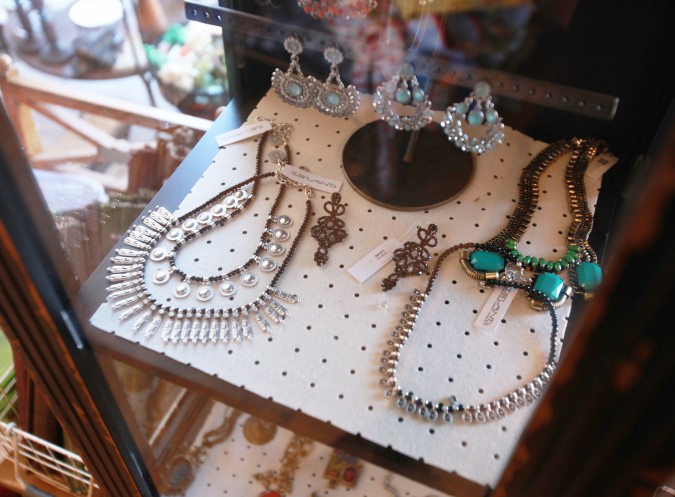
Jewelry for sale at Heartfelt gift store at 436 Cortland Avenue, San Francisco, California, USA, August 1, 2013. Photo by Kevin Warnock.
As soon as you check in, a horizontal red line starts sweeping up and down the phone display. The indicates the phone is looking for a bar code to recognize. I created a video of the ShoppinPal experience from checking in to just before payment. I have embedded the video into this post. The video is a bit shaky because I had to hold my large camera in one hand, and operate the app with my other hand, and since the phone was so close, the depth of field was shallow. But the video does show faithfully what the app does.
As soon as the app finds a bar code, it goes into search mode where it’s communicating with the cash register computer to find the item. This takes about two to six seconds. Then the item shows up in your shopping cart. From there it is confusing what to do next, since there is no ‘checkout’ or ‘buy now’ button. Instead, to continue shopping, you are to press the button in the upper left labeled ‘heartfelt,’ the name of the store. This should be labeled ‘back’ or ‘continue shopping.’ There is a button in the upper right called ‘cart.’ I didn’t try that button, but I assume that button takes you to the shopping cart from where one can checkout.
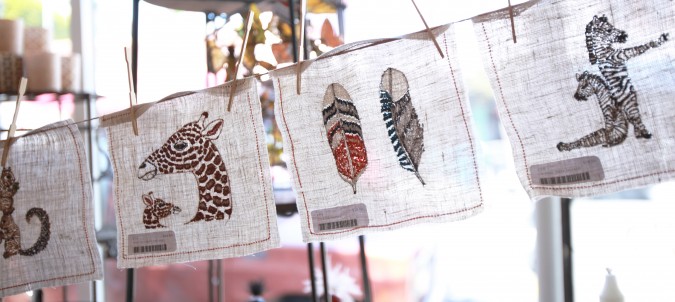
Textiles for sale at Heartfelt gift store at 436 Cortland Avenue, San Francisco, California, USA, August 1, 2013. Photo by Kevin Warnock.
I scratched off the panel as invited, and I got a 10% discount. I was given the chance to pay via credit card or PayPal, the payment service from auction giant EBay. I bought a lightweight wallet made from Tyvek, and I paid via PayPal. The process was quick and efficient, but my receipt listed my discount as $0.00 even though the 10% discount had been correctly applied to the total. I understand that ShoppinPal was only recently installed at Heartfelt, so I expect there to be small glitches to be worked out. For such an early stage yet ambitious application, ShoppinPal performed well.
As you might imagine, ShoppinPal has big dreams and has had sales meetings with huge brands that are household names throughout the US. I suspect that after they build their credibility with smaller retailers for the following months that they will land a national retailer.
ShoppinPal participated in 2012 in the Silicon Valley Bank Seed Showcase, a pitch event to investors for Silicon Valley Bank clients. Silicon Valley Bank is widely considered one of the most important banks in Silicon Valley for startups that aspire to or have raised venture capital investment. You can watch CEO Subramanian pitch on stage and then watch him later that day be interviewed by Carrie Walsh, Managing Director II, ESG, Silicon Valley Bank.
I could find no direct competitors to Fermyon.
The closest offering appears to be CardFree, which automates via a smart phone app some of the tasks that ShoppinPal automates, like payment and loyalty. But CardFree omits the ability to scan the barcode of products to bring up specifications and Amazon.com like product recommendations, two of the most compelling features of ShoppinPal, in my mind.
Another company that does part of what ShoppinPal does is CardStar from Constant Contact. CardStar appears to be a smart phone app just for storing and using loyalty cards from multiple retailers, so your physical wallet doesn’t burst from storing too many physical cards, like mine is threatening to do.
Another loyalty card company is BellyCard, which appears to be similar to CardStar.
Finally, there is a smart phone payment app called AisleBuyer, which lets in store purchasers pay via their smart phone. This company was acquired by Intuit in 2012.
See what former CNET Editor at Large Rafe Neeleman had to say about ShoppinPal in 2012.
The company’s name Fermyon is a play on the particle physics term Fermion. The definition of the Fermion is better left to the article on Wikipedia I just referenced.
I took the picture of Subramanian and Singhal that accompanies this post with my Canon 5D Mark II camera, my Canon 50mm f:2.5 macro lens and my Paul C. Buff Einstein studio flash unit.
The location of the photograph is the Skydeck accelerator run by University of California Berkeley. Jeff Burton is the Executive Director of Skydeck, and Burton encourages me to write about the UC Berkeley affiliated companies that the accelerator houses in its exceptionally glorious 10,000+ square feet of penthouse office space. If you look out the window in the center of the picture, you will see the clock tower that serves as the focal point of the UC Berkeley campus. ShoppinPal is headquartered at Skydeck, but this is not an indicator that the team is reckless with its finances. To the contrary, it’s an indicator that the team is careful with its money since the company’s office space is provided for free by the University of California, from where Subramanian earned his Masters of Business Administration graduate degree. Skydeck gives free office space to only the companies it deems most likely to succeed.
I became aware of Subramanian over the last year because we both attend monthly Cal Founders meetings, which are designed to help founders and mentors be more successful in business. Subramanian and I are more acquaintances than friends since we’ve only met and spoken a handful of times. He learned of this blog and asked if I would write about his venture, and I agreed because I had become intrigued when he had introduced his company during the roundtable discussions at Cal Founders meetings. I disclose the circumstances of how we met to deflect any appearance of bias due to my already knowing Subramanian.
11,750,000.00, not 10,000,000.00
Last week I was doing some research on my first Internet company, Hotpaper.com, Inc. I discovered a report I had never seen before, from PrivCo Media, LLC. According to PrivCo’s report, I sold my company for USD $11,750,000.00, which is more than I knew. The published price was $10M, but I always knew the actual price was technically higher because the acquiring company didn’t cancel the stock options of my employees. I never really found out the exact value of that part of the compensation, since I left the company soon after the deal closed, and I never went hunting for the number.
Launch party for Apple iPad fashion magazine and shopping app Monogram, at La Boutique l’art et la mode in San Francisco, California
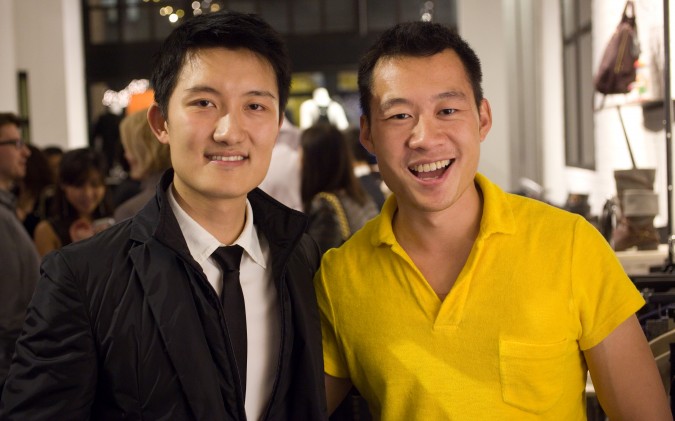
Leo Chen and Justin Kan at Monogram app launch party, 414 Jackson Street, San Francisco, California USA, November 27, 2012.
On Tuesday evening, November 27, 2012, I attended the launch party for a company run by Leo Chen.
Chen runs Fara, Inc., which recently released its first product, an app for the Apple iPad tablet computer.
The application is named Monogram, and that’s how I’ll refer to the company and product for the rest of this post, as the company doesn’t seem to promote the Fara name.
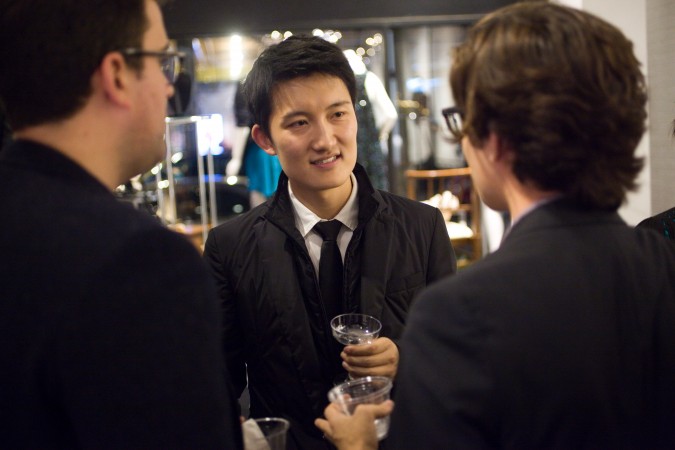
Leo Chen (center) talking with two guests at his launch party for his company's Apple iPad app 'Monogram', November 27, 2012, San Francisco, California USA
I met Chen July 18, 2012 at the Demo Day for the 500 Startups Accelerator program. Monogram was one of the presenting companies. I attended the Demo Day as a blogger so I got to meet all the graduating companies. Thank you to Dave McClure for getting me an invite to Demo Day. McClure is the founding partner of 500 Startups.
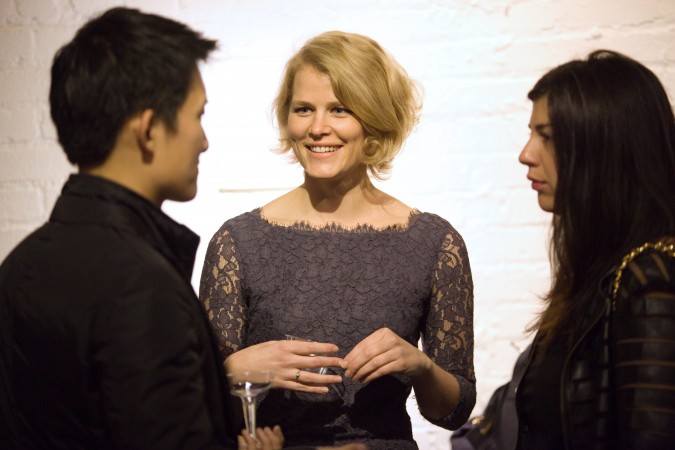
Leo Chen (left), CEO of Fara, Inc., talks with two guests at launch party for Monogram iPad app, November 27, 2012
Chen stood out because he was the most stylishly dressed. See my picture of him I took at Demo Day at the bottom of this post to see his pure white sports coat paired with jeans, a hip wristwatch and a pink shirt. Not many guys can pull off this eclectic look. That Chen can suggests he will have the fashion sense to make the right calls at Monogram, which, when you really study it, is a company that requires good taste to have a chance to thrive.
His app, which he demonstrated to me personally, was sumptuous, glorious and stunning — and it was still unreleased code.

Leo Chen on left talks with guest at Monogram iPad app launch party, November 27, 2012, San Francisco, California USA
I don’t have an Apple iPad, so I have not seen the released version of Monogram. Chen wasn’t showing off the app on his iPad at the party either, so I simply can’t write a review here of the app — sorry!
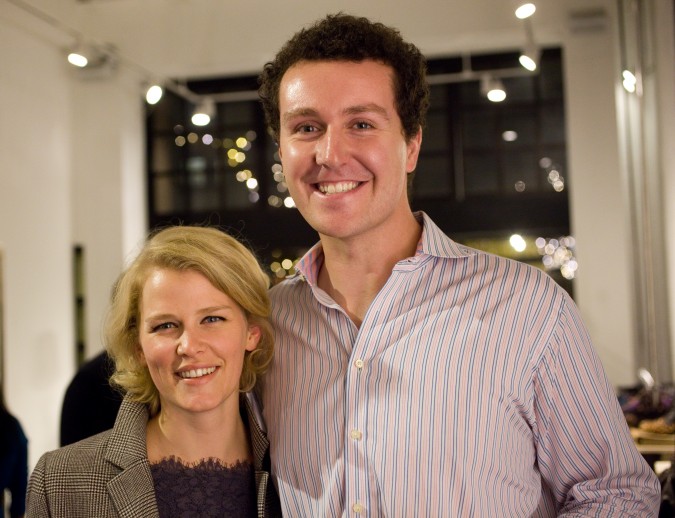
Fergus Hurley (right) at Monogram fashion magazine and shopping iPad app launch party at La Boutique l'Art et la Mode, November 27, 2012, 414 Jackson Street, San Francisco, California USA
The famous TechCrunch technology blog covered Monogram on November 1st, 2012 in an article entitled 500 Startups Alum Monogram Raises $400K More, Launches iPad App To Aggregate All Your Favorite Fashion Brands.

Kristen Slowe, Chief Creative Officer of Fara, Inc., the maker of the Monogram Apple iPad app, and her husband Chris Slowe, Chief Scientist at Hipmunk.
Since I can’t write a review about the Monogram app sight unseen, I’ll give you just the basics. You download the free app from the Apple App Store. You browse through pages of the app as if you’re looking at a fashion magazine. If you see something you want to buy, you can tap on it and get transported to an online retailer that sells that item. You’re presumably transported to precisely that item, not the front page of the retailer’s site. If you buy, Monogram collects an affiliate payment from the retailer, and that’s how Monogram makes money.
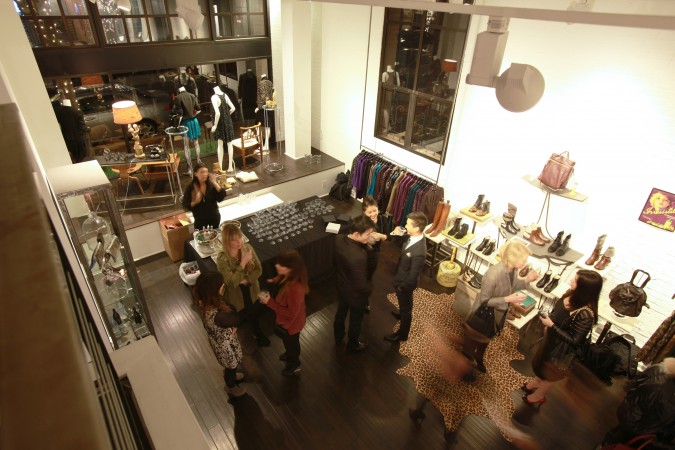
Fara, Inc. launch party for Monogram Apple iPad app at La Boutique l'Art et la Mode, 414 Jackson Street, San Francisco, California, November 27 2012
I met many of the attendees at the Monogram launch party, and I can say that Chen and his team have smart and impressive friends. The venue for the party, La Boutique – L’Art et la Mode, was perfect. Carole Harari, the owner of the boutique, has created a 2,500 square foot oasis that is part women’s clothing boutique, part art gallery, part furniture store and part event space. The women’s fashions for sale are eclectic and desirable.

Fara, Inc. launch party for Monogram iPad app at La Boutique l'Art et la Mode, 414 Jackson Street, San Francisco, California USA, November 27, 2012.
The pop up furniture store on the second level was so photogenic I took an architecture style picture while I was up there to get a shot of the crowd below. La Boutique is so photogenic that I asked Harari for permission to photograph models there.
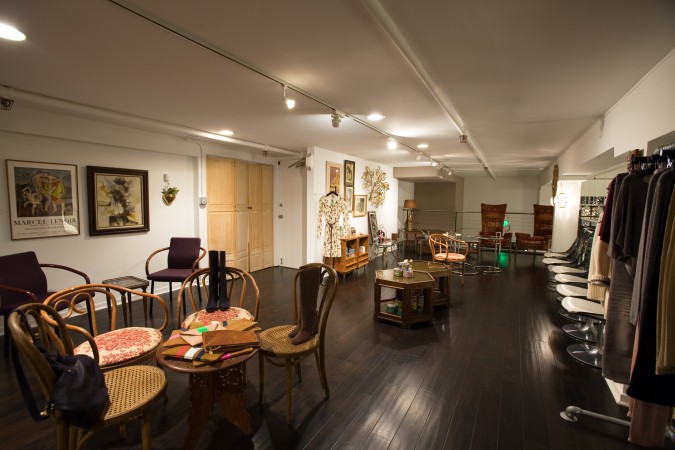
Upper level at La Boutique L'Art et la Mode, 414 Jackson Street, San Francisco, California, USA November 27, 2012.
I met Justin Kan for the second time. I met Kan for the first time — you probably have heard of his as Justin of Justin.tv fame — at a Stirr mixer in Palo Alto, California in about 2008. I spoke with him back then for perhaps 10 minutes, and they were a stressful set of minutes because he had a video camera strapped near his head and wore a backpack with four 3G wireless cards whose bandwidth was combined through software so the laptop in the backpack could broadcast Kan’s every move live to the Internet. This can be done with a smart phone today, but back then live streaming was rare, and my talk with Kan then was the first time I had been live streamed before a meaningful audience.

Justin Kan's Nixon brand watch on his arm, November 27, 2012, San Francisco, California, at Monogram launch party.
On Tuesday, Kan was wearing one of the largest watches I have ever seen, and it was so eye catching I asked to photograph it. I already had my macro lens on my camera, so it only took seconds to capture this shot you see here of Kan’s Nixon brand watch on his arm.
Leo Chen went to high school with Kan.
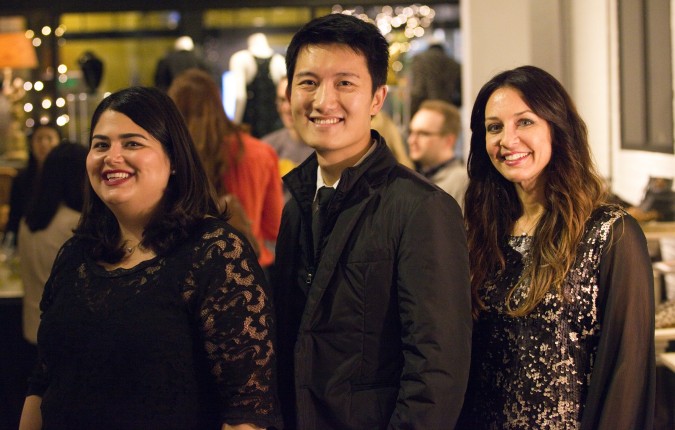
Kristen Slowe, Leo Chen and Kristen Philipkoski at Fara, Inc. launch party for Apple iPad app named Monogram. At La Boutique L'art et la mode, 414 Jackson Street, San Francisco, California USA, November 27, 2012.
Kan told me about his latest project, named Exec. Exec is an Apple iOS app that lets users hire an assistant for short term projects for a fixed rate currently of USD $25.00 per hour. An Exec assistant was stationed by the front door to La Boutique to make sure only guests on the list were admitted. I spoke with her for several minutes, and was impressed. I would use Exec if I needed an assistant for a project that Exec was suited for. One suggestion: When funds permit, buy the domain exec.com. The current url, iamexec.com, on quick viewing of the web browser address bar, reads as ‘lame exec’ because I saw the lower case i as an l. I had a good laugh about this, but I still recommend paying out the dollars to get the shorter url once it’s easily afforded. The url exec.com is currently up for sale, and has no developed site associated with it. Don’t wait too long, or the price will keep going up.
I also had a nice talk with the husband of Monogram co-founder Kristen Slowe. Kristen is Chief Creative Officer of Monogram. Her husband Christopher Slowe, is Chief Scientist at Hipmunk, which, according to their introductory video, ‘takes the agony out of travel search.’
Christopher and my father studied the same subject at the same university.
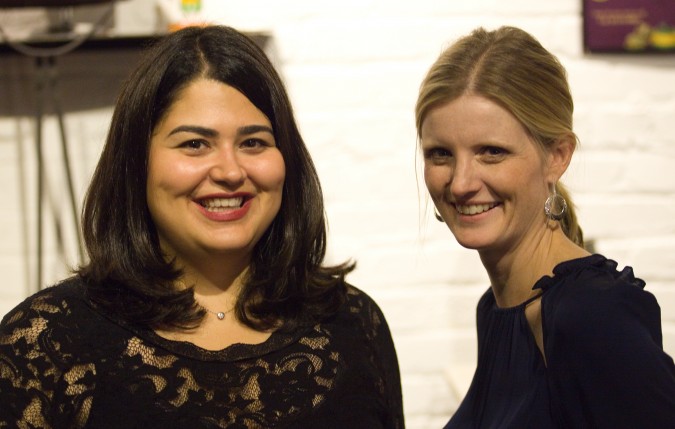
Kristen Slowe and Erin Flynn Hakansson at Monogram launch party, November 27, 2012, San Francisco, California USA
I got to talk with Jim England, a co-founder at Publik Demand. I met England at the same 500 Startups Demo Day where I met Chen. I absolutely love Publik Demand, a website that gives representation and power to consumers, so that they can insist that wrongs done by a company are addressed.
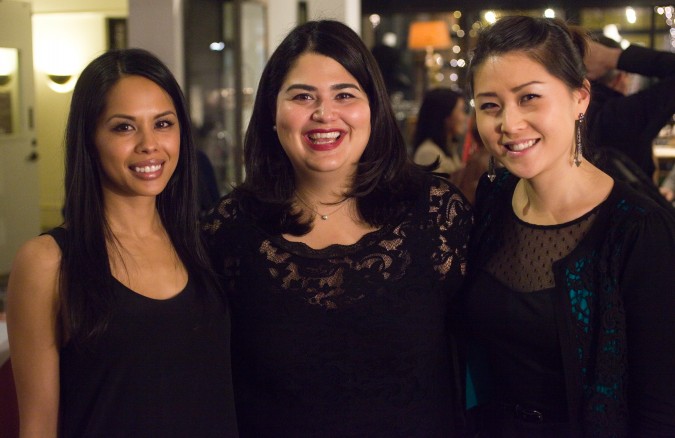
Lisa Garcia, Kristen Slowe and Sarah Choi from Monogram team at the Monogram launch party, November 27, 2012, San Francisco, California
I also got to talk with Cheryl Yeoh, co-founder and CEO of Reclip It, a website that brings together more than 200,000 online coupons & deals from many other coupon websites, for one stop access to money saving offers. I met Yeoh the same day I met England and Chen
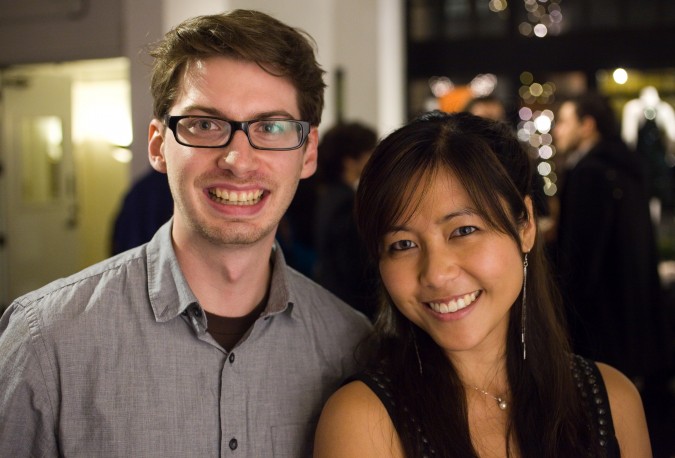
Jim England, co-founder of Publik Demand, and Cheryl Yeoh, CEO of ReclipIt, at Monogram app launch party, November 27, 2012.
I conclude with a photograph I love of Monogram co-founders Chen and Slowe that I took July 18, 2012 at the 500 Startups Demo Day, held at the headquarters of the publicly traded game company Zynga, at 699 8th Street, San Francisco, California USA.
I love Monogram, and that’s why I attended their launch party. I wish them the best of success. This is one of the few companies that truly counts on beautiful photographs for its success. Since I am an avid photographer, I connect with this company more than many.
Interviews with 10 entrepreneurs at the Lower Haight Urban Air Market, October 20, 2012, San Francisco, California USA
On Saturday, October 20, 2012, I attended the Lower Haight Urban Air Market. The two most commercially significant blocks, from 400 to 600, of the hip lower Haight street neighborhood of San Francisco, California USA were cleared of cars and closed for this interesting small street fair.
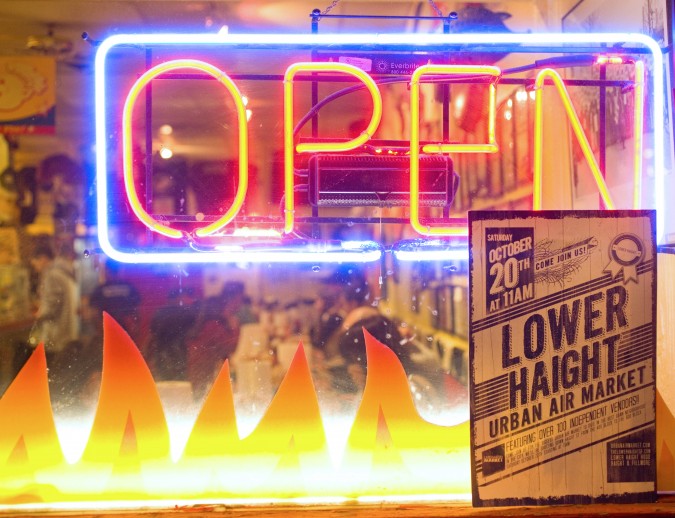
Memphis Minnies Barbeque Joint and Smokehouse, 576 Haight Street, San Francisco, California, October 20, 2012
Here’s a photograph of the poster advertising the Lower Haight Urban Air Market. The window is that of Memphis Minnies Barbeque Joint and Smokehose at 576 Haight Street. I took this picture after the sun went down but before it was completely dark. I haven’t eaten at Memphis Minnies, but I suspect it has quite a following given I see it has 1,127 reviews on Yelp today.
This project must have taken some real effort to plan and execute, because San Francisco’s Municipal Railway, MUNI, runs electric trolley buses on all of Haight Street. This street fair required that non-tethered buses be used instead for the day.
I don’t hang out in the lower Haight much, but Devon Chulick, one of the co-owners of the clothing store and art gallery D-Structure, alerted me to this fair via his store’s Facebook page. Since I’ve met some interesting people though Chulick in the past, I thought it would be smart to attend as a blogger to interview the most interesting entrepreneurs I could find, including the following ten entrepreneurs:
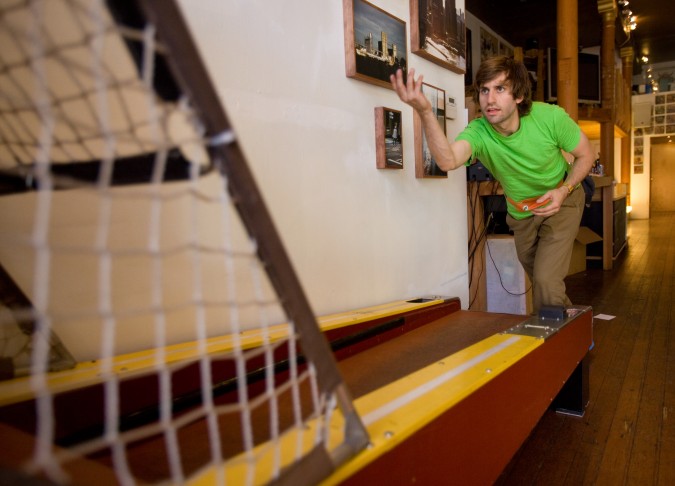
Joey Mucha playing his Skee Ball machine at D-Structure boutique on Haight Street in San Francisco California, October 20, 2012
The first entrepreneur I met was Joey Mucha. He buys used Skee Ball arcade machines, fixes them up, and places them at interesting non-arcade locations. He has a shipping container full of Skee Ball machines, and he knows how to fix them, even to the point of being able to diagnose and replace a bad computer chip on the machine’s scoring computer.
Mucha has one of his machines in Chulick’s D-Structure, and Mucha opened the machine up while I was there, so I could see how the score calculation system works. You can see Mucha playing the D-Structure Skee Ball machine in the photo above.
Amazingly, you can now play Skee Ball on your smart phone.
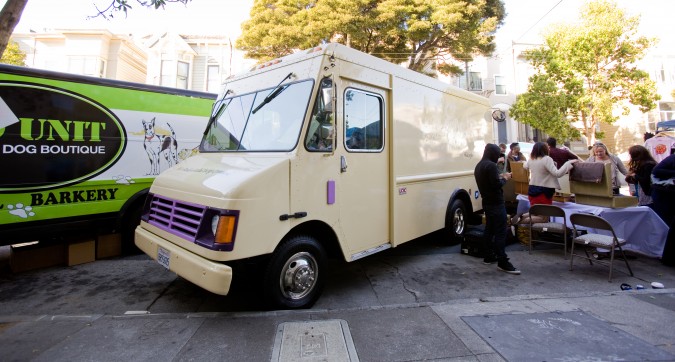
Jasy B clothing boutique inside a converted truck October 20, 2012, Haight Street, San Francisco, California USA
The second entrepreneur I met was Jasmin Baros. Baros introduced me to the concept of a clothing boutique being located in a converted delivery truck. I had never seen such a boutique, or even heard of them, until Saturday.
Baros is an accountant by profession. Her first experiment ten years ago with switching to retail didn’t pan out a after six month run.
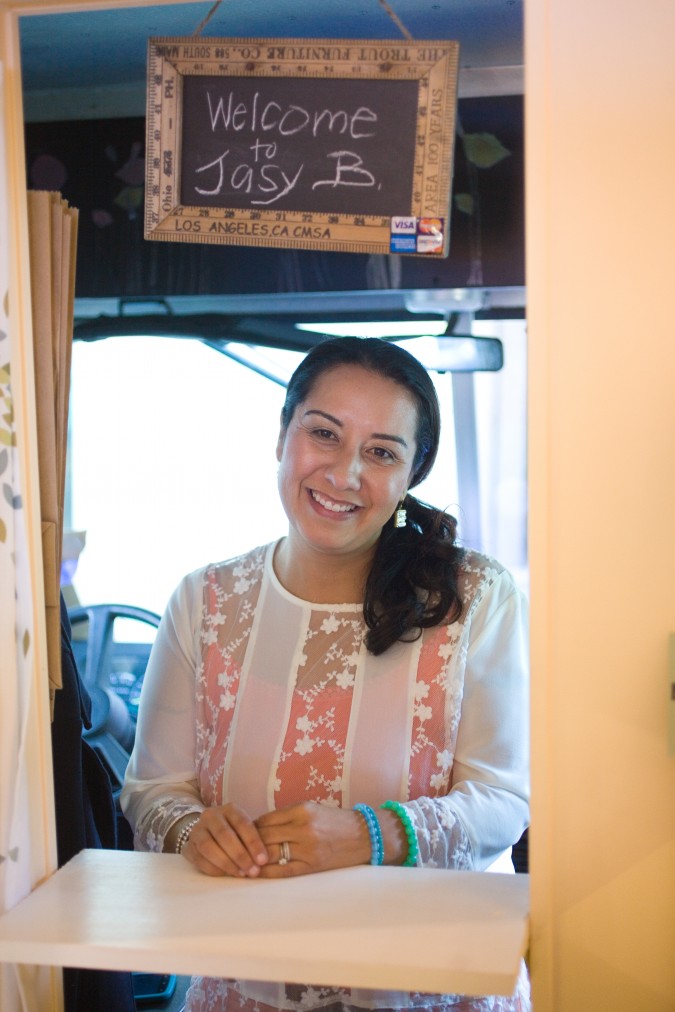
Jasmin Baros owner of http://jasybtruck.com photographed by Kevin Warnock, October 20, 2012, Haight Street Urban Air Market, San Francisco California USA
Her refurbished truck, just six weeks new, is her second attempt at retail, and I think her chances are better than 50/50 for a success. She bought the truck already freshly painted from a photographer for just USD $6,000, and only had to spend $2,000 having her logo painted on the side. It would have likely cost her $6,000 just for the fresh paint if she didn’t find an already freshly painted used truck.
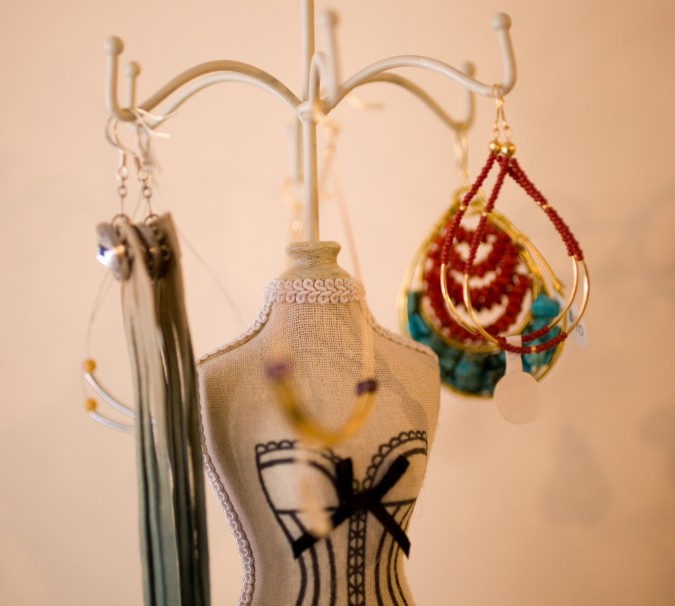
Jewelry for sale on Jasy B clothing boutique truck at Lower Haight Urban Air Market, October 20, 2012, San Francisco, California USA
Baros’ total cost to get into business she told me came to $25,000 — likely a fraction what it would cost to open a traditional retail boutique in leased store front space.
The truck — officially named the Jasy B Truck — is cute and inviting. The ceiling is pressed tin like you’d see in a vintage building. There is wainscoting on the walls. There is directional spot lighting. The colors are right. There’s a dedicated staircase with rails at the rear, where the door rolls up like a garage door. When the truck is parked at a 45% angle relative to the sidewalk, customers can just climb on board, in a way that feels natural and welcoming.
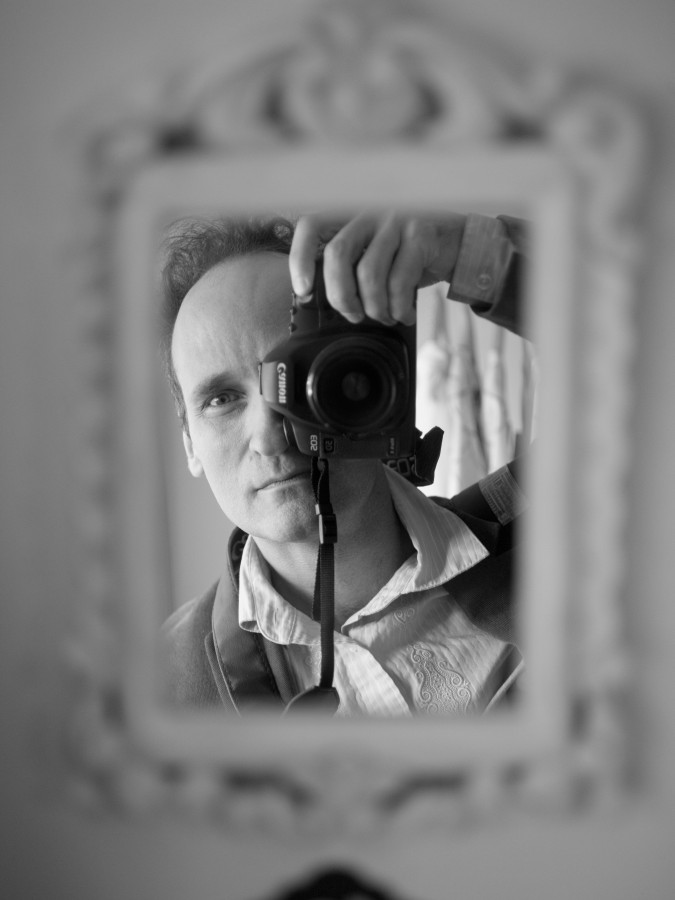
Kevin Warnock self portrait inside Jasy B truck clothing boutique, October 20, 2012, Lower Haight Urban Air Market, San Francisco, California USA
The Jasy B boutique on wheels had a wall mirror next to its jewelry display. I caught a glimpse of myself in this mirror, and since the mirror was small, it neatly framed my head. I snapped a picture with my Canon 5D Mark II digital camera I used to take all the photographs that illustrate this post. Note that I uploaded the pictures at full camera resolution. Click on them twice in delayed succession to see the full size versions, which are 21 megapixels.
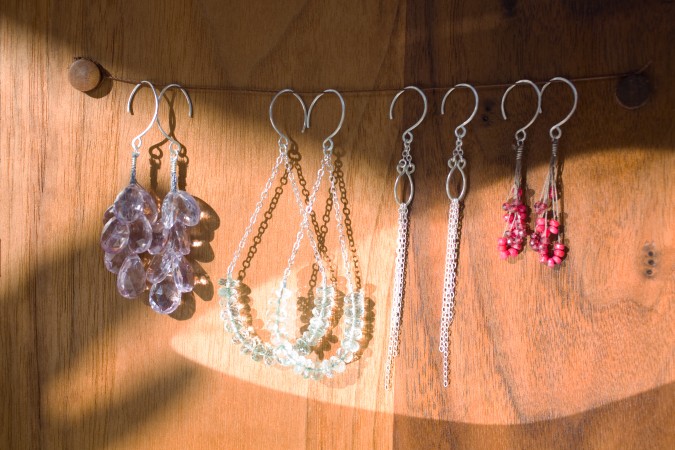
Sandra Kathleen Jewelry for sale at Lower Haight Urban Air Market, October 20, 2012, San Francisco, California USA
The third entrepreneur I met was Sandra Bowling, owner of Sandra Kathleen Jewelry. Bowling makes the jewelry. I asked permission to take the above photograph. Bowling gave permission and thanked me for asking permission. She said one woman particularly irritated her by taking pictures without asking, and when confronted, the photographer said she was going to send the pictures to a friend or relative (I can’t recall which) that also made jewelry for profit — to copy and then sell! I presume these designs are not patented, but still, I can see it being annoying having people taking pictures with the express intent of taking your work to profit from it.
Bowling had her jewelry nicely displayed, and I loved the light as shown in my picture above. The brighter spot of light in the lower right was from light bouncing off the hand mirror she had on the table.
Sadly, I forgot to photograph Sandra Bowling.
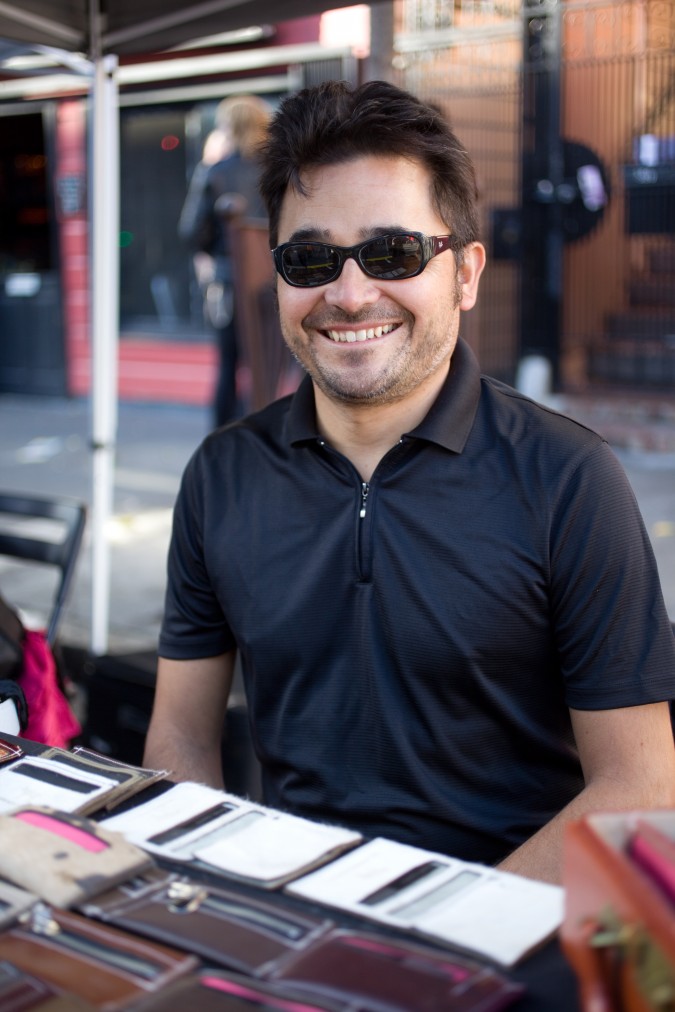
Angel Cantu founder of Halo Bender Design, a maker of upcycled leather wallets made from furniture leather samples, October 20, 2012, Lower Haight Urban Air Market, San Francisco, California USA
The fourth entrepreneur I met was Angel Cantu, above, founder of Halo Bender Design.
Halo Bender Design makes wallets for men from the leather swatches furniture stores have on hand to help buyers decide what leather to buy for custom ordered chairs and sofas. Cantu discovered that stores replace their swatch books from time to time, and when they do, they discard the old books. Cantu has learned that he can rescue the leather from landfill by giving the proprietor a few wallets he made from earlier swatch books. Since his materials cost is so low — thread and his time, this is a great exchange. The swatches he showed me looked brand new, and the wallets looked fresh and brand new as well, with no hint that their leather was perhaps already years old.

Wallets made by Halo Bender Design from furniture leather samples October 20, 2012, at Lower Haight Urban Air Market, San Francisco, California USA
Cantu cut the first wallets by hand with scissors. Then, he joined TechShop, a well equipped workshop that rents access to tools like a health club rents access to exercise machines. TechShop has a laser cutter to replace scissors, and industrial sewing machines capable of stitching leather. TechShop has spawned many small businesses, including DoDo Case, which makes an Apple iPad case that looks like a leather hard cover book. Current United States President Barack Obama carries his iPad in a DoDo Case brand case.
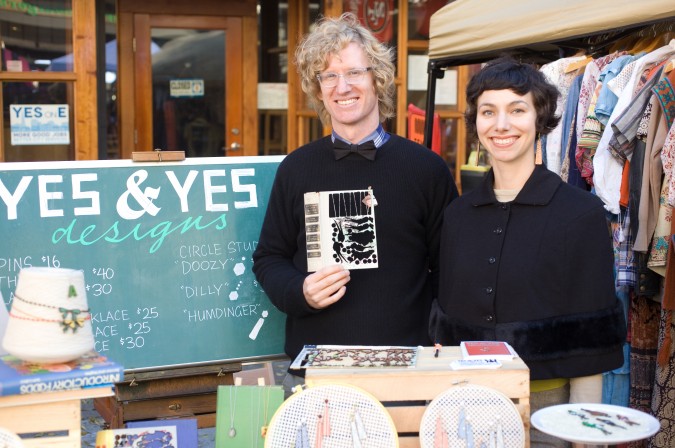
Laura Bruland the founder of Yes and Yes Designs with her boyfriend Julien Shields that works with her in the business, October 20, 2012, San Francisco, California USA
The fifth entrepreneur I met was Laura Bruland, founder of Yes & Yes Designs.
Yes & Yes is another TechShop success story, and she’s featured on their website.
Yes & Yes makes jewelry from old hard cover book covers. Bruland uses TechShop’s laser cutter to slice through the canvas and cardboard book covers in a way that would be nearly impossible with a jig saw or a Xacto knife.
In the picture above of Bruland with her boyfriend Julien Shields you can see Shields holding a book cover that has had over two dozen pieces of jewelry cut from it. The row of trapezoids on top became earrings, in the style you see Bruland wearing in the same picture.

Pins made from the covers of old books by Yes and Yes Designs, over rice, October 20, 2012, San Francisco, California USA
Many of Bruland’s designs feature the silhouettes of stylish women — Bruland confided that the designs themselves are vintage, derived from old dress making patterns. The pins above are examples of these designs. Look at how typography plays a part of her designs.
Like the upcycled wallets made by Angel Cantu, Bruland’s cost of materials is extremely low. She laser cuts out of date and falling apart books of nominal value as books. I suspect she pays little or nothing for most of the books.
I saw customers buying Bruland’s products, and saying nice things about them while doing so, something I didn’t happen to catch with any of the other artists at Saturday’s fair.
The sixth entrepreneur I met was Chris Steinrueck, co-founder of Wood Thumb, a maker of men’s ties and bow ties, among other products.
Wood Thumb recycles redwood it receives for free from Recology, the company that picks up the trash from homes and businesses in San Francisco. Recology sifts through the trash it picks up and hands the redwood planks it finds to Wood Thumb, which then planes and mills the ties into shape. The ties are cut on a ShopBot CNC router.
I love the upcycling and recycling demonstrated at this fair.
Wood Thumb started out at and still does some work at TechShop, like Yes & Yes Designs and Halo Bender Design, also profiled in this post.
The ties are made from redwood because redwood is attractive and particularly because it is light in weight. Chris, who runs the company with his co-founder brother David Steinrueck, said people can feel the difference in weight between redwood and other attractive wood, and prefer the light weight redwood. Conveniently, Wood Thumb ties are rot resistant, in case you forget your tie in the woods, unlike silk or wool ties.
Wood Thumb appears to be doing well, selling thousands of ties per month as of the end of 2011.
I photographed Chris with his girlfriend Rebecca Carrillo at their booth, also made from reclaimed wood.
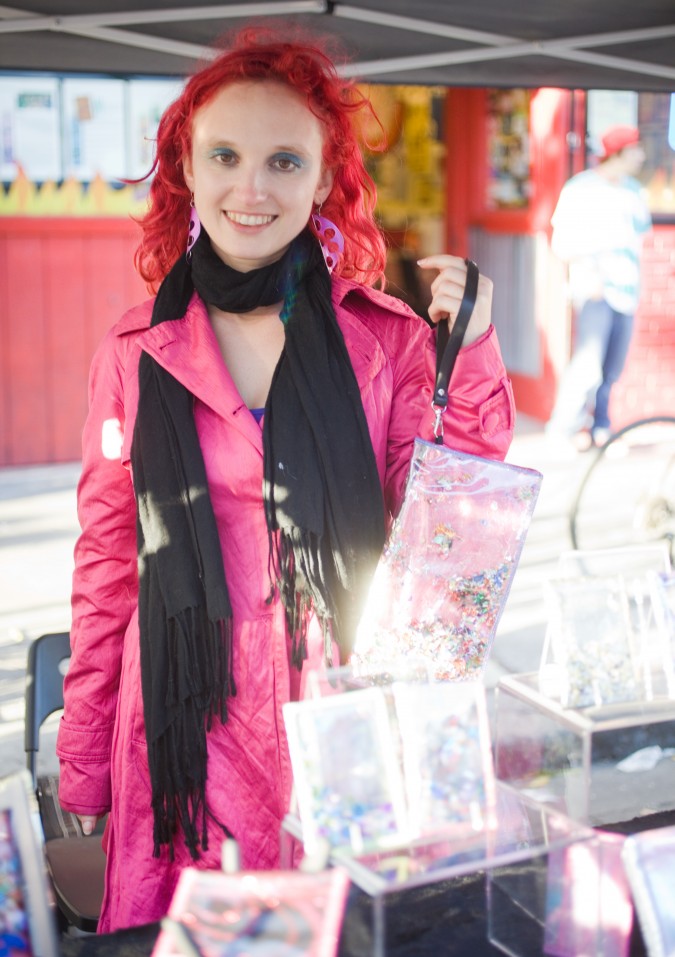
Sarah Boll owner of Glitter Disaster at Lower Haight Urban Air Market, October 20, 2012. Photograph by Kevin Warnock.
The seventh entrepreneur I met was Sarah Boll, who was the most interestingly dressed, with exceptionally red hair, vivid glittery blue eye shadow, a magenta jacket and wild black and white stretch pants she personally sewed. It was a look that is completely consistent with her product — glittery purses, clutches and related accessories. This was Boll’s first time selling at a street fair.
Her company name is Glitter Disaster — a name I really like.
The glitter you see in the clear vinyl is sandwiched between two layers, where it’s free to slide around like snow in a snow globe. The glitter never touches what you put into her clutches and purses. The random and ever changing glitter display catches your eye, and I think these products were the most inspired and unusual of everything I saw on Saturday.
Boll has an online store on Etsy, as well as a Facebook page and a Tumblr account.
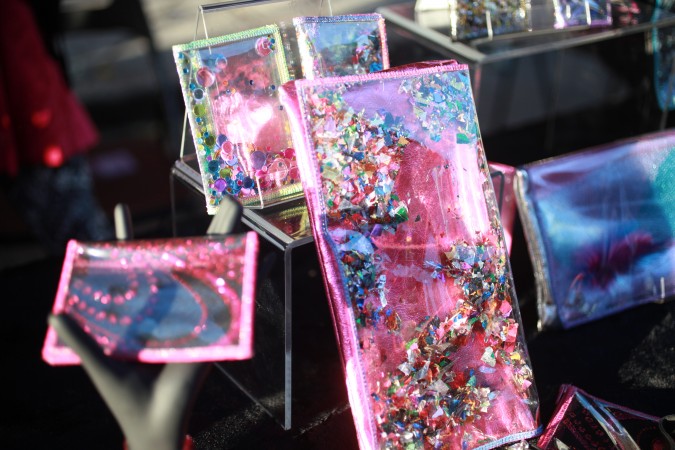
Glamorous accessories for sparkle connoisseurs by Glitter Disaster, October 20, 2012, Lower Haight Urban Air Market, San Francisco, California USA
The vinyl sheets are sewn not with a sewing machine but with a serger, called overlock machines outside of North America for the overlock stitches they create. If you look inside some of your clothes, you will see overlock seams. A serger is a fascinating machine. The overlock seam is not one thread but multiple threads, from separate spools. This means each thread can be a different color, a feature you can see Boll used to create interest with her pieces, since she uses the overlock seams as a visible design element.
I learned about the serger several weeks ago when I was looking into what I would need to sew my own clothes. I took sewing class at Lab School, and I made quilts when I was 12 years old. I want to make some really crazy outfits I can’t find in stores. That’s when I learned I would need a sewing machine and a serger machine. I have since decided to just wait until my next trip to Shanghai and have my clothes made in the world famous Bund fabric market, which will be more productive and more fascinating, because that stupendous fabric market has so many more fabrics than you can buy in the San Francisco Bay Area.
The eighth and ninth entrepreneurs I met were Misty Briglia and Sarah LaShelle, co-founders of Pretty Parlor beauty boutique on wheels. The Pretty Parlor is also built inside a retired delivery truck, like the Jasy B Truck. The beauty business is tightly regulated, unlike the retail clothing business. Thus, the Pretty Parlor truck has a bathroom complete with running water in a charming old world porcelain sink. There’s is room for a wheelchair to move around on board. A wheelchair ramp to board is in the works. I wonder if they can find a suitable aluminum ramp at a salvage yard that dismantles U-Haul trucks — those ramps are really well made.
In the photograph above, the woman in the gray sweater seated had just have her fingernails painted with intricate designs — a different design on each finger. I introduced myself to her and she let me see the results, which she really liked. She gave me permission to include her on this blog. The manicurist Mia Rubie, on the left, had her manicurist license out for display, just like you would see in a fixed location shop. I loved the antique furniture throughout the truck.
In the photograph above the founders Briglia and LaShelleare are sitting on the rear step of the truck. In the background, from let to right, are:
- Marie Rubie — Nail Artist
- Marla Kay — Esthetician
- Katie Stosic — Stylist and Receptionist
All of the trucks had generators chained outside sitting on the pavement. But I saw no heavy electrical requirement in any of the trucks. Since the trucks are only parked for the day, I think they all could switch to LED lighting and power themselves from a dedicated ‘house’ battery bank like those in recreational vehicles and bus conversions that charges from the vehicle alternator while driving. The generators are noisy and unnecessary. From what I could tell, none of the trucks contemplate air conditioning the sales floor while parked, but that’s the only reason for a large generator like the ones I saw.

Products for sale at Pretty Parlor beauty boutique on wheels, October 20, 2012, San Francisco, California USA
I recommend adding a solar panel to the roof to keep the batteries charged while the vehicles are in storage, and also to be able to boast that the stores are in part ‘powered by the sun.’ Solar panels are very affordable these days.
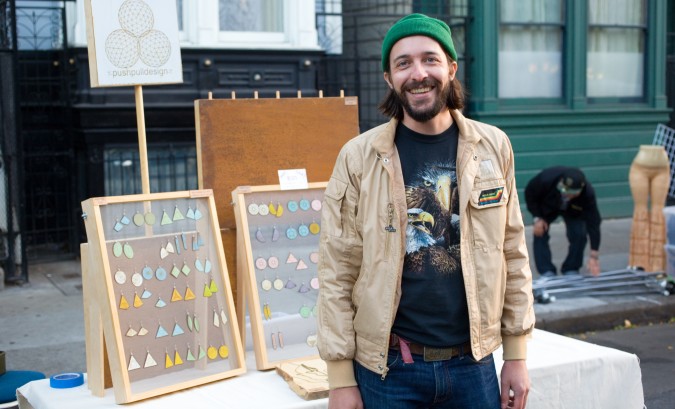
Aaron Bray, owner of PushPullArtDesign.com, October 20, 2012, Lower Haight Urban Air Market, San Francisco, California USA
The tenth and last entrepreneur I met was Aaron Bray, owner of Push Pull Art Design. Bray was at the fair selling his brand new but vintage appearing earrings and pendants.
He cuts the designs from steel with tin snips, and then flattens the cut edges with weights. He then treats the metal to give it a rich aged patina, rust I believe, that makes it resemble copper. I don’t know how Bray paints the pieces, and I could find no description on his website about how they are made. In fact, I could find almost no information about Bray online, and in particular, I could not find any pictures of him. I had Bray’s full cooperation to take the picture you see of him here.
I love Bray’s work, but I don’t understand why he is keeping such a low, low profile online. He should examine how Sarah Boll is using the Internet to promote her art. Bray’s online store is one example of how his low profile is hurting his finances. He sells only his discontinued work on his online store, but there are no ‘buy now’ or ‘add to cart’ buttons to be found. The price is a hyperlink, and if you click that you are taken to PayPal where you can buy that item. But that’s is expecting far too much from people to start clicking links looking for a way to buy. There needs to be a buy button on every item for sale, without exception.

Pendants by http://pushpullartdesign.com, October 20, 2012, Lower Haight Urban Air Market, San Francisco, California USA
The site is so sparse that it’s off putting. I can’t read Bray’s biography or see what he looks like. I can’t learn his phone number. I can’t determine what city, state or country he lives in, except by inferring based on the shows he notes he will attend. Even then, the list is heavy on abbreviations like SF for San Francisco, California. Buyers from other parts of the world may not know what SF means. I can’t learn what stores carry his products. I can’t see his products worn by people. I can’t even learn what the products are made from or how big they are, as there is no reliable size reference in any of the pictures.
Bray has the most subtle, artistic and lovely product of any that I have reviewed here, and I offer the above criticism in the hope that he will make simple changes that I predict will measurably increase his revenues and profits. Here’s one final piece of advice: Add your products to your Etsy store, which currently has zero products for sale. From what I have heard, Etsy really works.
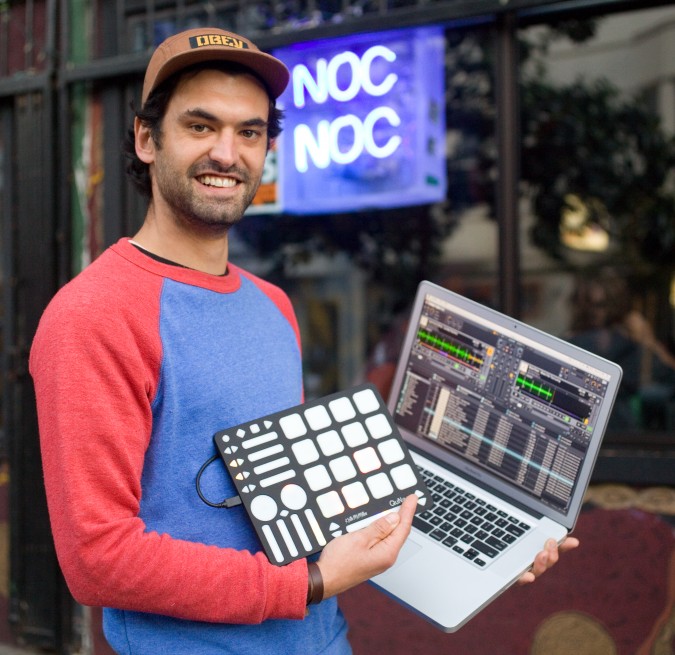
Matt Hettich is the Product Specialist / Artist Relations person at Keith McMillen Instruments, October 20, 2012. Photographed outside Noc Noc bar at 557 Haight Street, San Francisco, California USA.
The last person I met was Matt Hettich. He’s not technically an entrepreneur because he is not a founder of the company whose product he was pitching. But his product is interesting, and his approach to promoting it is also interesting, so I have included him in this post.
Hettich’s title is Product Specialist/Artist Relations. The company he works for is Keith McMillen Instruments. This company didn’t have a booth at the fair. I met Hettich as the fair was winding down, when I walked into the legendary bar Noc Noc that’s been in the same spot on lower Haight Street for decades. The decor hasn’t changed in decades — still the crazy handmade furniture and bar, which is holding up quite well considering the flow of hard living hipsters over the decades.

QuNeo 3D Pad Controller by Keith McMillen Instruments at Noc Noc bar on Haight Street, San Francisco, October 20, 2012
I met Hettich almost immediately because he was showing off the eye catching and colorful QuNeo 3D Pad Controller seen in the pictures above and below. This is MIDI controller for digital musicians and disc jockeys. The buttons on this controller are not labeled because they are mappable by software to whatever you want them to control. The buttons sense where you touch them and how hard you press, which for sounds like drum machines can be very valuable and can help musicians be more expressive.
I am not a musician, but Hettich did a great job explaining the device and why I would want one if I were a musician.
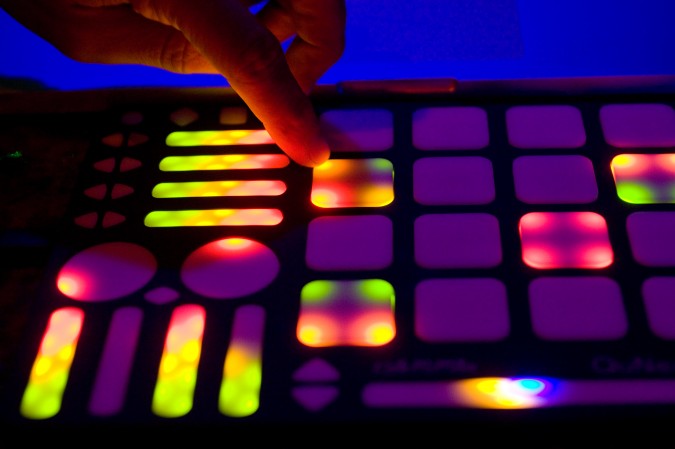
QuNeo 3D Pad Controller by Keith McMillen Instruments in use, October 20 2012, Noc Noc bar, San Francisco, California USA
Company founder Keith McMillen is a legend in the instrument business. One of the company’s customers was sitting with Hettich, and the customer compared McMillen to Robert Moog and Tom Oberheim, and said McMillen is in the same league. This stature probably explains why when his company ran a Kickstarter campaign to raise USD $15,000 he raised over ten times that amount.
The QuNeo costs just USD $249 — less than I guessed.
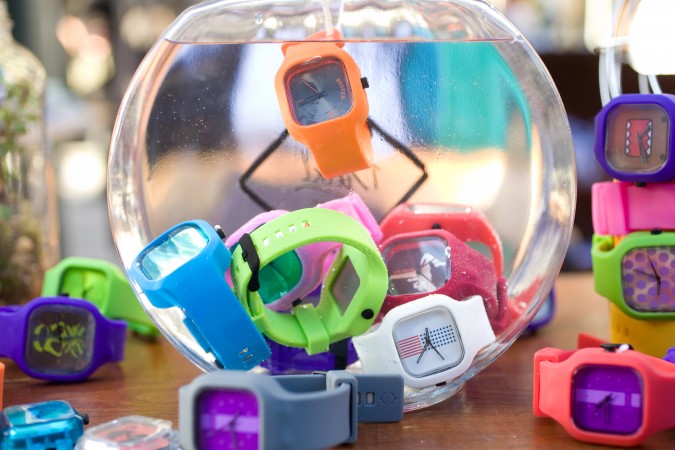
Modify Watches brand watches for sale at D-Structure at Lower Haight Urban Air Market, October 20, 2012, San Francisco, California USA
Here’s a pretty picture of some colorful silicone rubber wrist watches from Modify Watches, a brand of Modify Industries, Inc. I took this picture outside of D-Structure, where Chulick had a table of wares for sale. D-Structure carries Modify Watches at their store and online.
My friend Aaron Schwartz founded and runs Modify, and I’ve written about his products on this blog before. Schwartz has allowed me to borrow some of his products to photograph being worn by some of the models I photograph.
Schwartz’s company is a on a roll — his products were featured on the very popular United States television show The Today Show on October 3, 2012.
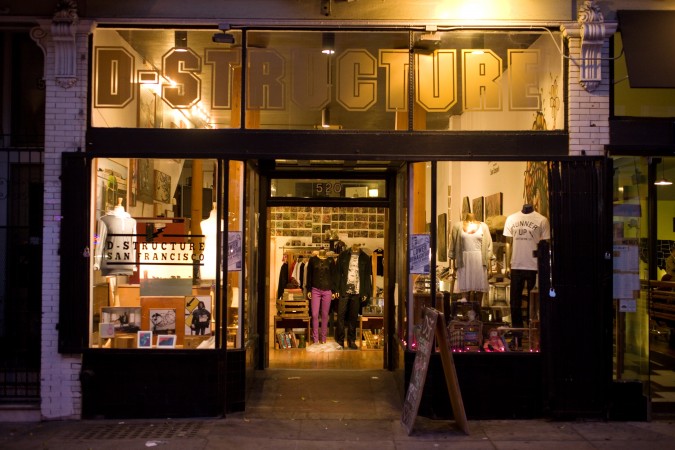
Magic Hour photograph of D Structure clothing boutique and art gallery, 520 Haight Street, San Francisco, California, October 20, 2012
After the fair ended, I took this picture of Devon Chulick’s D-Structure art gallery and boutique, just as the sun was going down. I thought the ‘magic hour’ light was flattering.
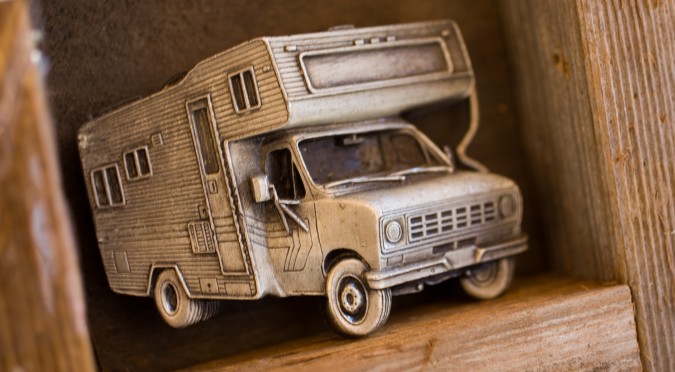
Class C motorhome belt buckle for sale by Staghound Belts at Lower Haight Urban Air Market, October 20, 2012
Finally, Staghound Belts had a booth where they sold new belts for men. They also had a collection of vintage belt buckles, including this buckle showing a Class C motorhome on a Ford van chassis. This made me think of George Lehrer, a blogger I’ve read for years. Lehrer for a decade now has lived full time in his Class-C motorhome he has named Ms. Tioga, after the brand name given by its manufacturer. He writes several times a day, and makes about USD $1,000 a month in revenue from Google Ad Words, which supplements his US Social Security retirement checks. I suspect Lehrer would like to have this buckle, and I further suspect that Staghound Belts will have it for sale for some time, as I doubt there is much demand for such a unique item.
It’s likely that Staghound made the belts they were selling, and I should have asked more questions so that I could have written about the founder as an entrepreneur. Next time I will.
[November 27, 2012 — I updated this post to name Julien Shields. The original version of this post referred to him as Laura Bruland’s boyfriend.]
40th anniversary party for the law firm Fenwick & West LLP
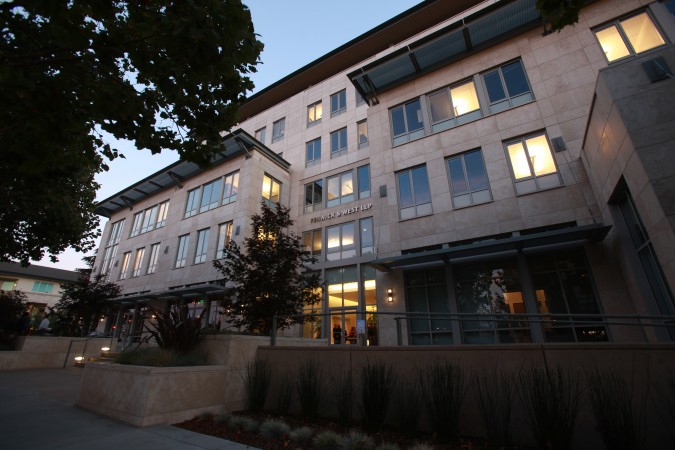
Fenwick and West LLP lawfirm 40th anniversary party September 19, 2012, Mountain View, California USA
Yesterday, Thursday, September 20, 2012, I attended the 40th anniversary party for the law firm Fenwick & West LLP at 801 California Street, Mountain View, California USA 94041.
My friend Sam Angus is a partner at Fenwick & West, and it was through him that I received an invitation.
I brought my camera but did not take it inside. This was a private party, and it didn’t seem right to attend as a blogger, which I typically do when I attend public events.
I did set up my tripod after I left and took this time exposure at dusk of the outside of the building. You can see the party through the front door. Click on this picture twice in delayed succession and you may be able to recognize the faces of the people by the door. You can certainly see the welcome sign on the stand outside the front door.
Fenwick’s chairman Gordon K. Davidson addressed the celebrants and shared some stories from the early days of the firm.
My favorite story was about Apple, Inc.
Fenwick’s first big client was Pioneer, the maker of entertainment electronics. I owned a Pioneer SX-1280 receiver from that era, though I bought it used for USD $100 years after it was manufactured, from my friend Dean Hinton. New it was over $1,000, far beyond my budget at the time. That receiver cranked out 185 watts per channel and weighed more than I did.
Pioneer engaged Fenwick to sue retailers for discounting its products, a type of lawsuit that was allowed back then.
One day Steve Jobs and Steve Wozniak came into their offices to incorporate their fledgling company Apple Computer. This was in the Apple I days — very, very early.
Founding partner Bill Fenwick had the good sense to take on Apple Computer as a client, and, I learned while researching this post, that Bill Fenwick did not charge for the incorporation work because he believed that Jobs and Wozniak couldn’t afford it.
I introduced myself to the hosts. I had a conversation with now retired founding partner Bill Fenwick, who asked if my father is John Warnock, the co-founder of Adobe Systems. I also spoke with current Fenwick & West chair Davidson. Both men were very gracious, and made me feel welcome. I can see how they were able to build a law firm that has become so well regarded.
Fenwick & West is one of the premier law firms in for technology companies.
I saw Dotty Damon Hayes, the mother of a friend, but she apparently departed early and I missed my opportunity to say hello to her again, which I regret.
The food, music, surroundings and guests were first rate. The Fenwick & West offices are understated and elegant. I was particularly impressed that the kitchen area occupies what otherwise would have been a sought after corner office. I spoke with many of the guests, and really enjoyed myself… thanks Sam for the invite.
Happy 40th birthday Fenwick & West!
Modify Watches trunk sale and party at D-Structure at 520 Haight Street, San Francisco
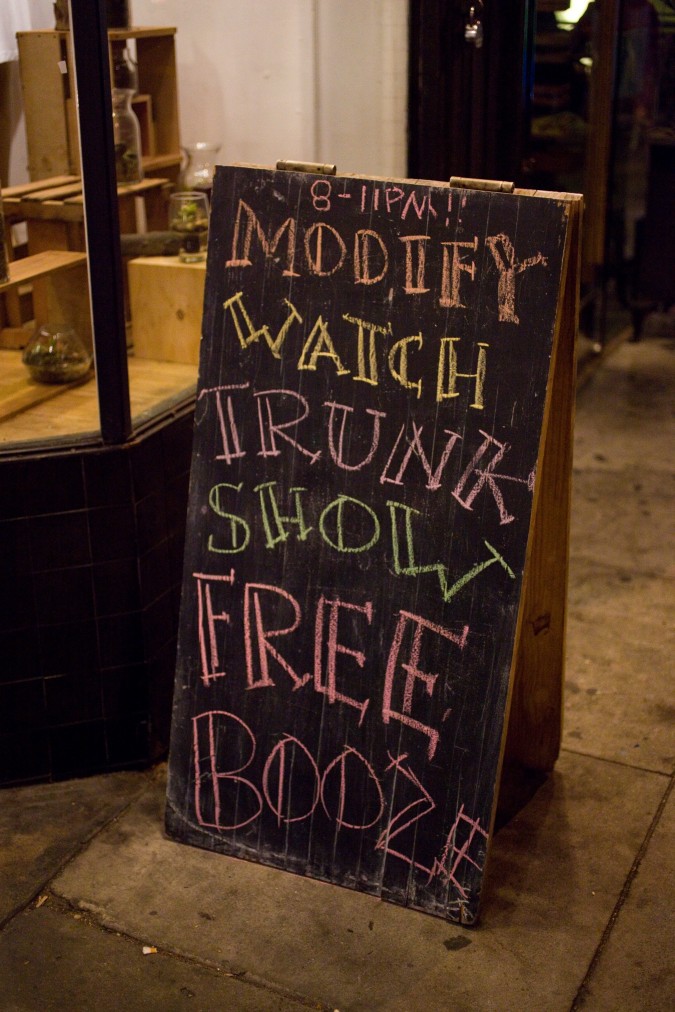
Modify Watches trunk show sign at D-Structure, 520 Haight Street, San Francisco, California, August 25, 2012
On Saturday, August 25, 2012, I attended a trunk sale at D-Structure, a clothing boutique and art gallery at 520 Haight Street in San Francisco, California USA.
Modify Industries, Inc. was the guest of honor at this trunk sale, showing their fashionable colorful Modify Watches brand wrist watches. The vibe at this trunk show was outstanding, due in part to the trendy location of D-Structure, between Mad Dog in the Fog at 530 Haight Street and Cafe International at 508 Haight Street, in the Lower Haight neighborhood.
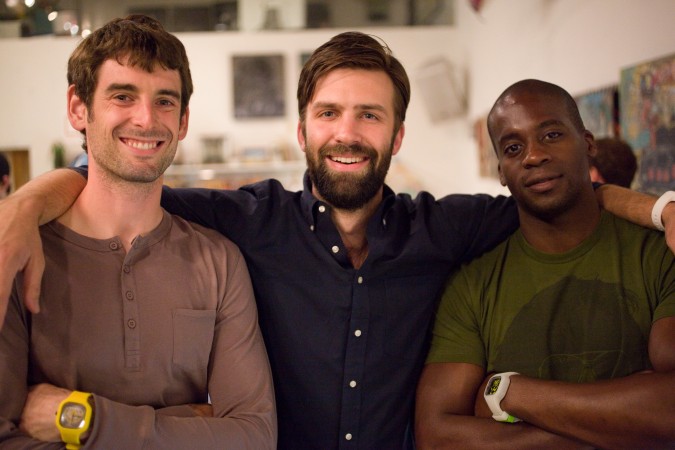
Aaron Schwartz, Devon Chulick and Ayo Oluwole at D-Structure, 520 Haight Street, San Francisco, California USA, August 25, 2012. Photo by Kevin Warnock.
I got to meet Devon Chulick, one of the co-owners of D-Structure.
Chulick told me that Aaron Schwartz came into his store to propose that D-Structure carry the Modify line.
Schwartz is the CEO of Modify Industries, and I didn’t know he made sales calls like this. Chulick told me he is totally bombarded with pitches from companies asking his store to carry their products, so Schwartz had to clear a high bar to get his product into D-Structure, which, from what I can tell, is well curated for its location and apparent target customers.
Schwartz, Chulick and Ayo Oluwole are pictured together above. Each is wearing a Modify Watches watch.
Oluwole is the VP of Marketing for Modify Watches. He used to live in New York where he did marketing for true luxury brands like Salvator Ferragamo. At Modify, I see evidence of Oluwole’s past experience with luxury goods — even his business car looks luxurious, with one rounded corner and muted pastel colors.
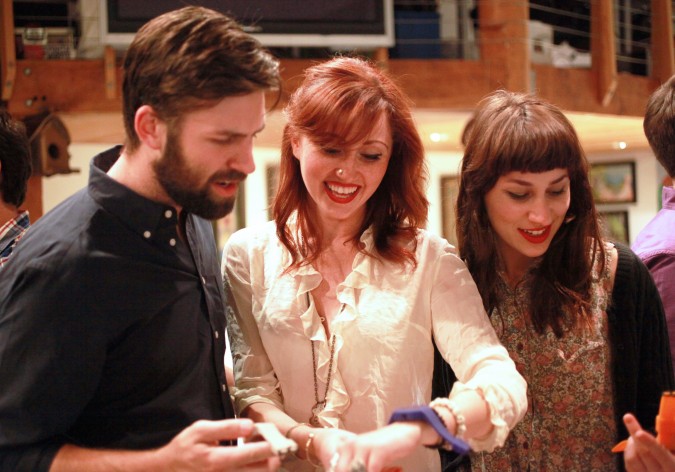
Devon Chulick, Hana Alyssa Sidia and Mary Frances Knapp at D-Structure, a clothing boutique at 520 Haight Street, San Francisco, California, August 25, 2012. Photo by Kevin Warnock.
Schwartz is a great salesman, once selling thousands of watches to a Silicon Valley company that’s known world wide after he was randomly seated on an airplane flight next to a buyer from that company.
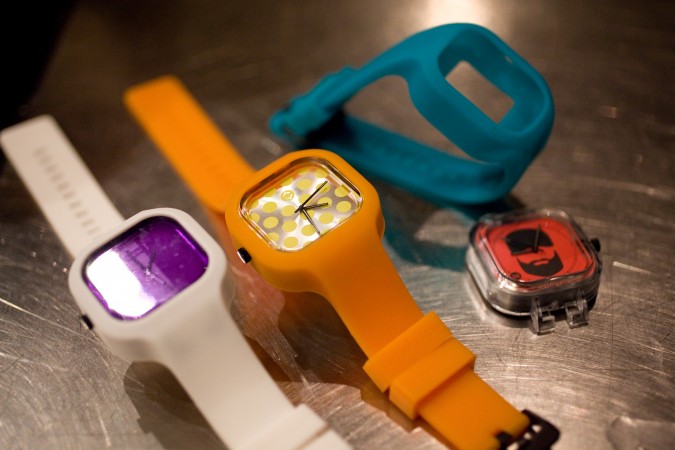
Modify Watches brand wrist watches by Modify Industries, Inc., August 25, 2012, D-Structure, 520 Haight Street, San Francisco, California USA. Photo by Kevin Warnock.
The watches are named Modify Watches because they are so easy to modify, without tools. The strap is made of soft and pliable silicone rubber, so one may take out the hard plastic time piece just by pushing it out of the strap. In the photograph above, you can see two complete watches on the left, and an empty watch band on the right, with the time piece sitting next to it. The time pieces and straps come in small and large — for women and men. The straps come in dozens of colors and the time piece inserts come in dozens of designs. Companies can order custom faces for the time pieces, in quantities as small as 200, the last time I heard. The swap-ability of the straps and time pieces gives buyers more fashion looks for less money. Modify Watches are simply fun, so I can see people buying them even if they carry a mobile phone, which, after all, is close to carrying an atomic clock in your pocket, because cell phones would not function if not for the extreme precision of the clocks the carriers use to make cell phone networks operate.
I’ve written about Modify Watches brand watches before, so I’ll tell you a bit about D-Structure. The store is beautiful — hip, quirky, warm and energetic. There was a quality DJ on hand for the event, and the sound system had quite good fidelity, and was loud enough to make you feel like music is a key element of the marketing strategy for the venue. It wasn’t loud like a nightclub, but it wasn’t soft either. It made the event feel like a real event, not a sales pitch.
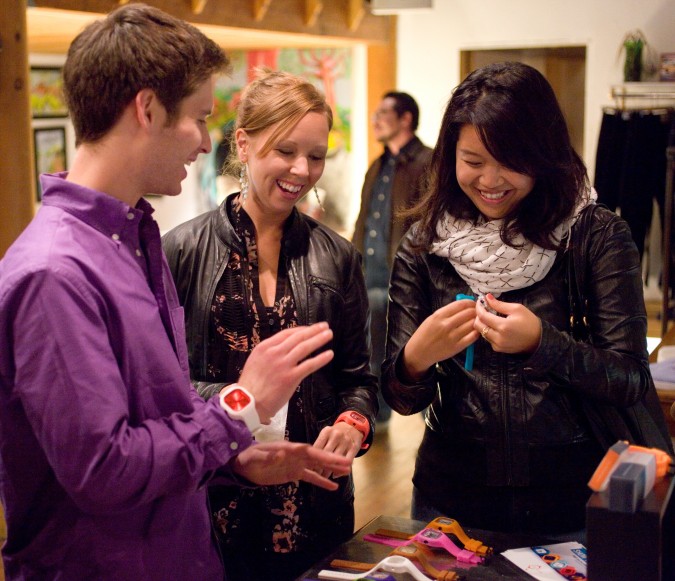
Devin Hexner and three fans of Modify Watches at D-Structure clothing boutique, 520 Haight Street, San Francisco, California USA, August, 25, 2012
Devin Hexner, an intern at Modify Watches, kept busy, and seemed to be doing a good job. I overheard him talking to some fans who work at a big national retailer, and Hexner sure looked like he was making a good impression, from all the smiles and laughter I saw.

Julia Garcia, left, and Shane Rand, right, at Modify Watches trunk sale at D-Structure at 520 Haight Street, San Francisco, California USA, August 25, 2012. Photo by Kevin Warnock.
I met a lot of people at the event. I spoke for a bit with Julia Garcia and her friend Shane Rand, pictured above. Garcia introduced herself to me because I had on my crushed red velvet sports jacket I got at a pop up sale for 90% off its original eye popping four figure price. I almost didn’t buy that jacket because I worried it would make me look like a young Hugh Hefner. I am thankful I bought it, since I have never owned an article of clothing that has garnered more compliments.
I would love to conduct one of my photoshoots of models in this store, with the model or models wearing some of the outfits the store has for sale. The location is very photogenic, as you can see in the photographs that I took that illustrate this post. Garcia and Rand are photogenic, so perhaps I can photograph them in the store, if they find this post and are interested.
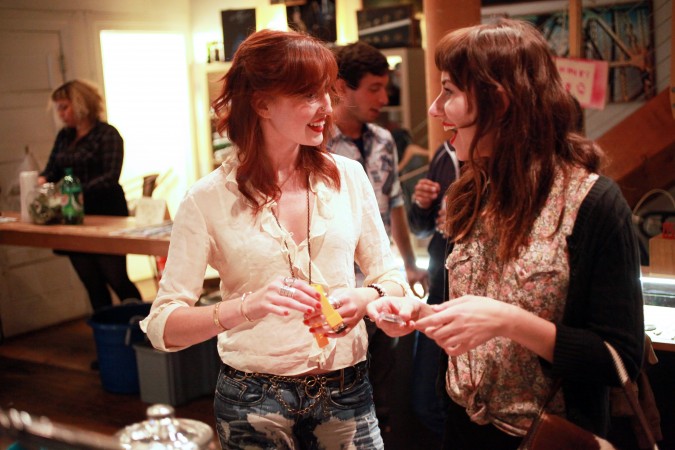
Hana Alyssa Sidia and Mary Frances Knapp at D-Structure August 25, 2012, 520 Haight Street, San Francisco, California USA. Sidia and Knapp are trying on time pieces by Modify Watches.
Hana Alyssa Sidia and Mary Frances Knapp, the only two models I introduced myself to at the event, are photogenic, and I would enjoy having a chance to photograph them properly, with my lights and reflectors.
This trunk show was at night and I used only the ambient light available. This means I had to choose an ISO setting of 4,000, so these pictures are more grainy than usual. I upload my photographs at full camera resolution of 21 megapixels. To see the full size versions, click on the pictures twice in delayed succession.
The artwork is interesting — not something I would buy for my home, but it was engaging and fun. Totally appropriate and it improved the aesthetic of the shop. I especially liked the ‘antiques’ on display as decoration, including several manual typewriters from 50 or 75 years ago, and several cameras from the same time period.
Yellow 108 brand hats looked great. I need to get into wearing hats.

Old camera for decoration at D-Structure, 520 Haight Street, San Francisco, California, USA, August 25, 2012
Look, a Schneider-Kreuznach lens on a camera that didn’t display its own brand where I could see it. I love old cameras.

Clothes on rack at D-Structure clothing boutique, 520 Haight Street, San Francisco, California, August 25, 2012
Modify Watches are water resistant, a point hammered home by the three watches on display in a bowl of water, above.
Modify Industries is on a roll. I enjoy attending their events. Schwartz has allowed me to borrow some of his company’s products, which I have some of the models I work with wear on camera. I will return all these watches, and I did not write this or any post about Modify in exchange for this loan. Schwartz is my friend, and I like writing about companies where I know the founder or founders. I make this disclosure because it may be legally required.
Modify Watches retail launch party at Hangr 16 boutique in San Francisco, California USA, August 9, 2012
On Thursday, August 9, 2012 I attended the retail launch party for Modify Industries, Inc.
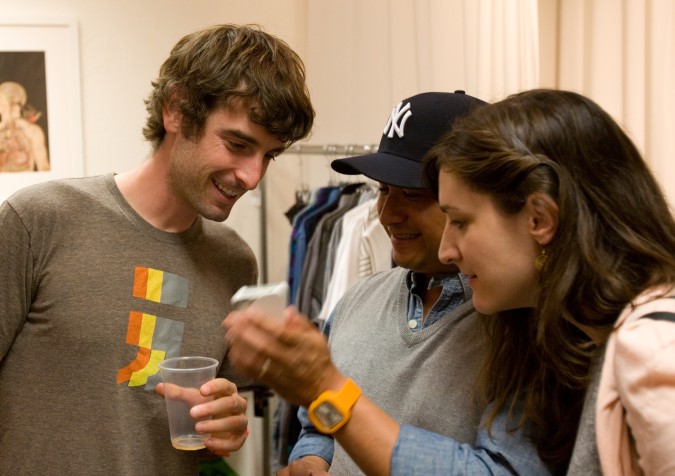
Aaron Schwartz, left, CEO of Modify Watches, checks out an Apple iPhone app August 9, 2012 at Hanger 16 at 3128 16th Street, San Francisco, California USA
Modify Industries is the company behind the colorful and fashionable silicone rubber Modify Watches brand watches that feature time pieces that without tools may be interchanged between bands. You can see people wearing Modify Watches in the top three photographs that illustrate this post. The watches come in two sizes. There are dozens of time pieces and dozens of straps (bands) to select from.
Modify Watches was a finalist competitor in the 2012 Berkeley Startup Competition at the University of California. That competition is very competitive, and it’s very difficult to become a finalist, as there are only eight per year, while most years more than 100 teams apply to compete.
I am friends with Modify CEO Aaron Schwartz.
Click here to see all my blog posts, past and future, that I have written about Modify Watches.
Modify has focused its attention on eCommerce sales and enterprise sales. It has achieved impressive success in both areas, selling to big companies including Google.
Now Modify is moving into retail by selling to boutique retailers.
One such boutique is Hangr 16 at 3128 16th Street in San Francisco, California USA, near Valencia Street. Hangr 16 carries the Modify line of products. The store’s energetic and charismatic buyer, Liddy Parlato, decided to sell Modify’s eye catching line after she opened an email targeted to her store from the company. Parlato told me she gets 30 pitches a day by email. Parlato’s store is spare and elegant, with a well curated selection. It’s not jammed with hundreds of product lines like many boutiques. Thus, Parlato’s decision to carry Modify’s products is a win for Schwartz and his team. Parlato is one of four owners of Hanger 16. She comes from a background in advertising, not retail.
While researching this blog post, I learned that Hangr 16 was voted the Best Clothing Store for Men by readers of the San Francisco Bay Guardian weekly newspaper. That makes the store’s decision to sell Modify Watches all the more special.
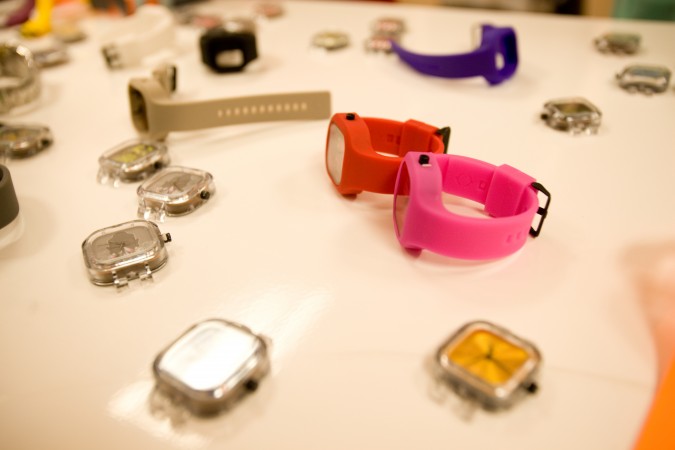
Modify Watches still life at Hanger 16 retail launch event August 9, 2012 at 3128 16th Street San Francisco, California USA
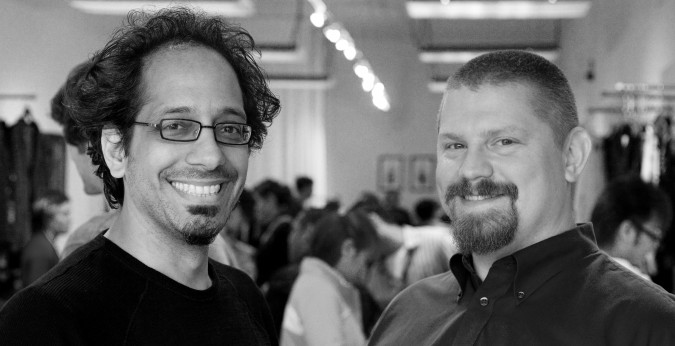
Abie Hadjitarkhani and Nathan Dintenfass, founders of Hotel Delta, at Modify Watches retail launch party, San Francisco, California USA, August 9, 2012
Abie Hadjitarkhani and Nathan Dintenfass attended the launch party. I know Dintenfass from the Haas School of Business at the University of California Berkeley. I met him while he was getting his Masters of Business Administration degree. I participate in many events at Haas to help the students and by extension The Lester Center for Entrepreneurship and Innovation.
Dintenfass and Hadjitarkhani run Hotel Delta, a boutique consultancy that helps entrepreneurs create great products.
Hotel Delta produces the Products are Hard conference.
Nathan Dintenfass is one of the smartest entrepreneurs I know. I have spent hours listening to him advise startups, and his wisdom is evident and deep.
Congratulations to Schwartz and his impressive team at Modify Industries. I predict great things to come.
I took the pictures that accompany this post. I uploaded them at full camera resolution of 21 megapixels. Click on them in delayed succession to see the full size versions, which are larger than your screen.
Legal disclosure — Schwartz let me borrow six of his company’s watches so that I may photograph them being worn by the female models I photograph. I pursue photography as a hobby, and do not charge for my work, so perhaps this disclosure is not legally required. To cover my bases, I am disclosing this loan. I proposed this arrangement, not Schwartz. I would have written this post even if Schwartz did not let me borrow any watches. I will return the watches to Schwartz once I photograph them with some additional models.
World of Good Inc. thanks me for investing my money
I was the first financial investor in World of Good, Inc not related to the company founders by family.
I participated in the Series A, Series B and Series C rounds, after which the company was acquired.
I met founders Priya Haji and Siddharth Sanghvi in about 2005, the day they moved into the Berkeley Entrepreneurship Laboratory in the basement of The Bancroft Hotel across the street from the University of California at Berkeley. That startup space is now closed, in favor of new space at the top of the tallest building in Berkeley, California. The new name for the Berkeley Entrepreneurship Laboratory is UC Berkeley Startup Accelerator@Skydeck.
My desk was just inches from Haji’s desk, and we became very good friends, talking on the phone for hours a week.
Haji is the woman on the left in the photograph at the bottom right above.
World of Good was acquired in early 2010 by two companies.
Greater Good, owned by Charity USA bought the wholesale division of World of Good, Inc. This part of the company sold thousands of products to over 1,000 retail stores, including Whole Foods Market, among many others.
eBay bought the World of Good brand name and the matching Internet domain name so the online marketplace created earlier by both companies together could continue.
Here is the February 25, 2010 press release by World of Good, Inc. announcing the acquisitions:
“World of Good Inc. Sells Brand and Related Assets to eBay; Wholesale Division Acquired by GreaterGood/Charity USA
World of Good Brand Continues to Represent Sustainable Shopping and Market Access for Global Artisans Through E-Commerce
EMERYVILLE, Calif. – February 25, 2010 – World of Good Inc., a five-year-old social venture that connects artisans from developing communities with mainstream retail markets, announced today that eBay has fully acquired its brand and related assets. World of Good Inc. also announced that GreaterGood/Charity USA has acquired its wholesale division and line of designer, Fair Trade products which will be re-branded, while existing relationships with retailers and artisan partners will be maintained. The terms of the transactions were not disclosed.
eBay’s acquisition of the brand results from a two-year long collaboration between the two companies that led to the development of WorldofGood.com by eBay, the world’s largest multi-seller marketplace for socially and environmentally responsible shopping. The transaction reflects eBay’s growing commitment to engaging consumers to affect social change through sustainable commerce. It also represents World of Good’s commitment to creating the greatest market opportunity for small, Fair Trade and environmentally responsible producers around the world. The online marketplace hosts hundreds of sellers, with tens of thousands of sustainable products from 85 countries.
“We are excited about the opportunity to scale the World of Good mission to an unprecedented degree through eBay,” said World of Good co-founder and CEO Priya Haji. “Also, we are confident that GreaterGood will be an excellent steward of the retail partnerships we’ve built and will continue to grow Fair Trade through mainstream retail channels.”
GreaterGood’s acquisition of World of Good’s wholesale division reflects its growing Fair Trade business, including its Global Girlfriend apparel line. Since 2004, World of Good has developed extensive retail product lines for partners like Whole Foods Market, Hallmark and Disney, among others. GreaterGood will continue to work with the same retail partners and artisan groups in order to grow market access for small artisan suppliers around the globe.
World of Good was founded in 2004 by U.C. Berkeley’s Haas Graduate School of Business MBA’s Priya Haji and Siddharth Sanghvi with the mission to help small artisan producers improve their livelihoods by providing them with access to mainstream retail markets. The company has impacted more than 40,000 individual artisans across 70 countries by connecting them with millions of U.S. consumers. Haji also founded World of Good Development Organization, a sister non-profit focused on improving the lives of low-income women in the developing world. In December 2009, the Development Organization was honored by The Tech Museum of Innovation for its Fair Wage Guide, a free, open-source platform that calculates fair wages for artisans around the world and specific to their locations. The organization will continue its work to create technologies and tools that help companies ensure fair wages to informal sector workers.
Robert Chatwani, Director of eBay Global Citizenship said of the acquisition, “We look forward to this next step in our commitment to building an integrated, sustainable shopping experience within the eBay marketplace and are dedicated to applying our reach, resources and business model to create a positive impact for people, the planet and communities throughout the world.”
“GreaterGood is excited to grow the retail partnerships that World of Good built and to continue to help small artisan and Fair Trade producers reach these important retail channels,” said Stacey Edgar, founder and president of Global Girlfriend and director of the GreaterGood Wholesale Division.
About eBay:
Founded in 1995, eBay Inc. connects hundreds of millions of people around the world every day, empowering them to explore new opportunities and innovate together. eBay Inc. does this by providing the Internet platforms of choice for global commerce and payments. Building on this positive foundation, eBay’s sustainability efforts harness our technology and reach to extend this positive impact into vibrant, sustainable commerce experiences. Our sustainability portfolio includes WorldofGood.com, the eBay Green Team, the eBay Foundation, eBay Giving Works and MicroPlace.
About GreaterGood/Charity USA:
The GreaterGood Network of websites (including TheHungerSite, TheBreastCancerSite, TheAnimalRescueSite, Global Girlfriend, and others) offers the public a unique opportunity to support causes they care about through a free daily click and Gifts that Give More™ (100% of these donations go to the cause of the patron’s choice). The GreaterGood Network’s online stores offer more than 3,000 Fair Trade items, with up to 30% of the purchase price going to charity. In fiscal year 2009, the GreaterGood Network gave more than $3 million to more than 50 charities around the world.
Media Contacts:
Lonnie Shekhtman, World of Good
240-601-5824, lonnie@worldofgoodinc.com
Annie Lescroart, eBay
(408) 376-7458, anlescroart@ebay.com
Rosemary Jones, GreaterGood/Charity USA
206-268-5496, rosemary@thehungersite.com“
Haji and Sanghvhi worked incredibly diligently on World of Good.
You may click on the image of the thank you poster above to see it at full size, which will enable you to read the captions, which tell of some of the many successes World of Good is responsible for achieving. World of Good sent me the poster you see above in a beautiful frame, and I have it displayed in my home.
So that the captions can be found by search engines, here they are in text form:
- Provided artisans in 70 countries access to new markets and enabled 50,000 people, mostly women and children, to earn better livelihoods through fair trade.
- Supported the create of the FairWageGuide, being used to improve wages of informal sector workers by 600 companies in twenty countries.
- Sold over three million fair trade and handcrafted products.
- Made fair trade accessible to millions of Americans and allowed them to make more informed choices.
- Partnered with Fortune 100 companies, including eBay, Disney, Hallmark, Walmart and Whole Foods Market, to held them source products ethically.
- Completed 28 economic development projects that included schools, wells and healthcare initiatives in twenty countries.
I am proud to have invested in World of Good.
I meet the Picatcha.com team at the University of California Berkeley Skydeck startup accelerator
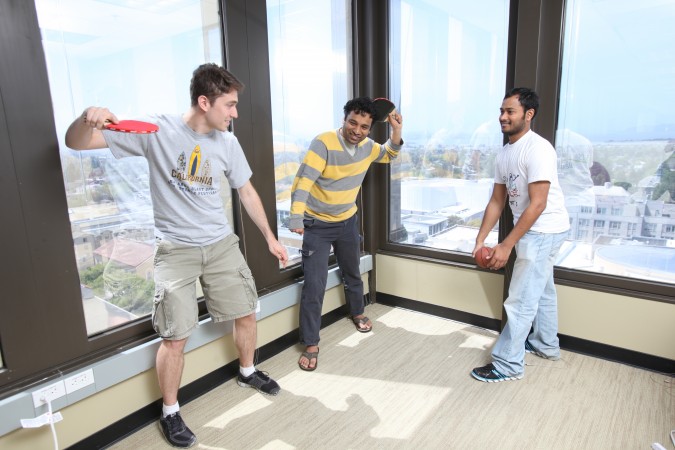
Picatcha.com team playing ping pong with a basketball. May 2, 2012, at University of California Berkeley Skydeck startup accelerator. Photograph by Kevin Warnock.
On May 2, 2012 I met with Satish Polisetti, Dhawal Mujumdar and Sean Carey of Picatcha.
Picatcha is a made up word combining ‘picture’ and ‘Captcha.’
Captcha stands for Computer Automated Public Turing Test to tell Computers and Humans Apart. Captchas were invented by researchers at Carnegie Mellon University.
Even if you don’t recognize the word captcha, you know the test. Here’s an example of Captcha used by Facebook [where I encourage you to subscribe to my posts]:
This Captcha was posted to the photo sharing site Flickr because the first word is difficult to read. You can see Flickr user Chance Abbatoir couldn’t make out the word and wrote wtf? in its place. Wtf is short for ‘what the fuck’ for my readers who aren’t familiar with this slang term.
This illustrates the problem Picatcha is trying to solve.
Regular Captchas similar to the example from Facebook here are too easy for computers to figure out. That allows bad guys to do things they should not do, like buy hot concert tickets as soon as they go on sale, bumping out actual people by overwhelming the websites where the tickets are sold, such as at TicketMaster and Live Nation. The ticket sites assume the buyers are legitimate because the Captchas are correctly deciphered. As a result, more concert goers have to buy their tickets at inflated prices on the secondary market.
In response to such fraud against web properties, traditional Captchas are getting more difficult for humans to solve, such as the one shown here from Facebook. I suspect it says ‘N 1/4’ but I can’t be certain. Can you?
Computers and software are improving. There’s an arms race between conventional Captcha writers and the bad guys. The bad guys are winning.
Picatcha has a different approach.
Picatcha presents a challenge that’s currently difficult for a computer to solve.
The Picatcha twist is that users are asked to look at a set of images and identify the subset that matches a word. For example:
In this example the user has to click on the two middle pictures on the top row, and the second and last picture on the second row. Teaching a computer how to solve this puzzle is much harder than training optical character recognition software to decipher regular Captchas, according to Picatcha. Think about it from the computer’s perspective… the Picatcha way requires machine vision to identify arbitrary objects. OCR only has to deal with 26 letters and 10 digits. A computer trained to break Picatchas would have to handle a vast array of images, which could be crude line drawings up to detailed color photographs.
Picatcha does a lot of other things that make it more compelling than what I’ve so far described.
They allow customers to use images of their products in their picture captchas. Imagine how this would thrill consumer product companies. Imagine how personal this makes the test for users. Suddenly the access tests can become fun, not irritating.
You solve Picatchas by clicking or touching, not typing, making them much more friendly to solve from smart phones and tablets.
There’s extra tricky security happening under the covers, I was told, so this is not a quick programming project to duplicate.
Even more compelling is the Picatcha system can vary the images depending on who the user is. That’s right, the system can tap into your location and demographic data that Picatcha has access to via commercial ad serving services. This strikes me as a brilliant way to enhance user satisfaction and make it more likely they’ll sign up for or buy whatever is behind the Picatcha.
I am impressed with Picatcha. So were the semi-final round judges for the 2011 University of California Berkeley Business Plan Competition, hosted by The Lester Center for Entrepreneurship & Innovation and led by Executive Director André Marquis. Picatcha competed in that competition in 2011 and advanced to the elite final group of eight teams [Note to the Berkeley Business Plan Competition organizers: Keep these links valid in perpetuity. Right now it appears only two years of winners are identified at your site. All winners and finalists back to the 1999 inception of the competition should be listed. Thank you.]. Picatcha collected a cash prize for their efforts. It’s very, very difficult to advance to the finals in that competition… I know as I was a semi-final round judge in that competition. I was not a judge for Picatcha, as I served on the Products & Services track, and Picatcha competed on the Information Technology & Web track. I did not meet the Picatcha team last year at the finals, as I was not yet a tech blogger.
Picatcha started as a school project for Co-Founders Mujumdar and Polisetti when they were students at the School of Information at University of California, Berkeley. They described their work in an attractive summary report. Their Advisor was Bob Glushko.
Picatcha is a hosted service, so its customers don’t need to install any software on their web servers. According to the front page of the Picatcha website today, the company has served up over four million access tests so far, on over 200 customer websites.
When I was meeting with Co-Founder Dhawal Mujumdar last week, he showed me the Picatcha implementation for a brand so famous you are all but certain to have heard of it if you live where their product is sold — M & Ms, the chocolate candy from Mars that melts in your mouth, not on your hands.
Picatcha is sharing office space with other impressive startups at Skydeck, the startup accelerator at University of California at Berkeley, in Berkeley, California USA. I met the Picatcha team after I informed Eliot Sun from Kloudless, Inc. that I’d like him to introduce me to another team, as I had time before my next meeting, and I wanted to be productive. I’ve wrote about Kloudless yesterday, May 7, 2012. I took the pictures for this post. Click on them to see them at full 21 megapixel resolution. There are many more good shots of the Picatcha team playing basketball ping pong in a public album on my Facebook page.



